
The legacy continues by our making available the original Marshall- and VOX-style Radiospares (AKA “RS”) transformer designs — some of the most unique and highest quality transformers ever made. Ask any British guitar amp aficionado about Radiospares and they’ll bend your ear for hours about the these incredible-sounding VOX and Marshall amps.
Mercury is extremely proud to offer these outstanding transformer designs. All Radiospares transformers come with both our 10-year Workmanship Warranty and Tonal Guarantee. Radiospares transformers may be used for upgrades, replacements or custom tube-based guitar amp applications.
To find out more, or discuss to discuss the characteristics of the different transformer sets available for your amps, give us a call or email.
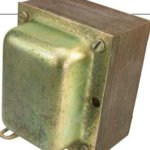
A few months back, we restores a 1960 Vox AC15 to it stellar sonic signature. But as with all vintage amps, you never know when something might go on the fritz!
We had just tightened the last screw and powered up the amp to unleash some ear candy when – major bummer – there was a noticeable loss of signal. After a diagnostic check, everything pointed to the output transformer. So it was off to Mercury Magnetics and the meticulous mind of its founder, Sergio Hamernik, to re-wind this 51-year-old piece of harmonic history back to spec.
VG: So… is it all over for this output transformer?
Sergio Hamernik: Well, it appears that it’s given up its ghost. A major bummer to say the least! Replacing a transformer in a guitar amp is a similar feat to heart surgery. But it’s NOT “All Over Now Baby Blue” because we’re going to fix it. And when we do, it’ll likely sound better than the original.
This output transformer is an original, from 1960. The late 1950s into the early 1960s was a transitional period for VOX. And one in which their transformers were known to have various failure rates, depending upon which batch ended up on the chassis.
In your case, someone from the original transformer company had the bright idea of using low-cost wax instead of a varnish dip. No doubt to save their six-pence. To be fair, most transformer companies back then were somewhat ignorant to the unique demand placed on transformers by the guitar amp builders. As a means to inhibit rust on the iron core and also to fortify the insulation of the windings, the industry standard is to dip and bake transformers in varnish, NOT wax. And you know what happens to wax when it heats up!
When we originally opened this amp up, there was wax all over the chassis that had to be scraped out.
There is some merit to using wax if the component doesn’t generate much heat above ambient temperatures. Output transformers do not generate much heat by them themselves. Especially when they’re working within their design specs – even with the amp cranked. But what the original transformer maker failed to take into consideration was all the tubes packed in there next to the transformers on a limited size chassis. As you might have already experienced when you try to pull a tube from a powered up amp – they do get really hot.
Class A amps run hot because they’re designed to run wide open, no matter where you’ve set the knobs. Now enclose this or any amp into a box and you have created an ideal environment for a large temperature rise above room temperature. You can practically see the wax dripping off the transformer.
Plus, VOX amps are notorious for getting hot inside the cabinet anyhow.
Yeah, but VOX wasn’t the only company that stuffed wax transformers into their hot boxes. As we discovered during the course of rebuilding transformers from old Dynaco, Sunn, Marantz, and a few others, they tried this idea and had their share of failures, too. Using wax as an insulator would never fly today because it’s is extremely flammable. Is there such a thing as a nonflammable wax candle? Today’s amps though are probably the safest they’ve ever been.
How long did this wax-period last?
A few years of trial-and-error seems to have put a stop to that practice. The interesting thing is that among the first VOX amps built they used Radiospares transformers. Radiospares were extremely well constructed, varnished and expensive for their day. VOX amps with these transformers are highly sought after (“pre-wax debacle era”). However, I don’t believe VOX ever intended on using Radiospares for anything but prototyping and the earliest short-run productions.
Back then Radiospares catalogs were essentially England/Europe’s equivalent of the American Allied/Radio Shack catalog stores. We’ve run across a few early AC30s that came with their full compliment of Radiospares transformers. If they had failed it was due in part by operator error and not the construction of the transformers themselves.
It seemed that shortly after the Radiospares era VOX began to solicit other transformer companies. An early one that comes to mind was Parmeko. Based upon our forensic investigations, Parmeko seems to have been a low-bidder – which was clear by their rather feeble attempt to copy the Radiospares. Also, the Parmeko output transformers were dumbed-down with cheap materials and short-cut winding methods. Their transformers were in no way even close to the Radiospares quality, as their lack of tonality proved.
The engineering of the original Radiospares designs and workmanship are highly respected by us. They’re extraordinary, and for that time they really raised the bar – as demonstrated by Eric Clapton’s sound on the “Blues Breaker” album – a JTM-45 Marshall using the same Radiospares transformers!
What time period are we talking about?
This was during the first year of production for VOX of these amplifiers.
So… the output transformer in this AC15, is that a Parmeko?
No. It’s definitely after Parmeko, which once again marks another transitional period in the company’s history. Soon after Parmeko, VOX found another transformer supplier, Woden, a former military supplier who bid low to get the VOX order. Your transformer shows all of the tell-tale signs of it being a Woden.
Woden had some problems with quality and consistency. So the performance of their amps varied from transformer batch-to-batch. I wouldn’t be surprised if Woden was behind the idea of changing their production run to wax the transformers. Many amp players and collectors are quite fond of these Woden-era amps.
The Beatles era marked another transition for VOX. From Woden to Haddon, and Haddon is generally what people recognize when they think of that Beatles sound. Haddon was another former military contractor, but a step UP in build quality and consistency and probably cost from the Wodens.
If I were to purchase a vintage AC30, for example, I would look for the ones with Haddon transformers, although I still prefer Radiospares because they consistently give that benchmark tone. When the Beatles and the British rock seen took off in the early ’60s, VOX grew into a big corporate thing. At that point the Haddons were becoming just too expensive – so enters another transition in their transformer suppliers – a lower-cost company called Albion.
Although VOX saved money with Albion, their transformers created an interesting and more aggressive new VOX tone. Sadly, right after the Albion era the company went to Thomas Organ and shifted over to solid-state circuitry. And as we all know those were a part of VOX’s darker years.
The Albions do have a small group of followers that really dig that sound. But when I’m thinking “VOX” I’m really talking about the goose bumps that the Beatles era gave me with the Haddons. George Harrison had no problem overdriving his VOX amps into that unmistakable jangle and sparkle tone. Nor did Brian May with his signature thick and creamy textured sound.
For the record we have cloned Radiospares, Parmeko, Woden, Haddon and Albion transformers from that era and make them available in our catalog.
Did this transformer die because the wax had melted away?
Probably not. This transformer lost its wax at least 40 years ago. But even that’s okay. I have built amps and prototypes in the past where I used unvarnished transformers and they performed just fine. The main purpose varnish or wax is basically to coat the iron core. Rust proofing it because the better the grade of iron the greater the chance for rust to settle in. London fog didn’t help things either. Actually the coil’s insulation itself doesn’t always depend upon the use of varnish. So your transformer probably led its life mostly free of the wax, and it still performed well.
So why did the transformer die?
Transformers are not apt to commit suicide… no matter how poorly one plays the guitar. Transformers in general are not subject to the effects of aging. Instead, they usually die at the hands of others.Consequently, it’s almost always some outside operating condition or an offending part.
There are a few exceptions though. These come from some well-known and liked amplifiers that over the years have fallen victim to self-destructing transformers. Time bombs of a sort stemming from historically problem-laden transformer designs. More often than not inadequate internal insulation systems. An amp that comes to mind is the first generation of Marshall Majors. Their power transformers would frequently fail from voltage breakdowns. These transformers were a bit oddball since they didn’t appear to follow the build methods of the Drake transformers which are found in the 50 and 100 watt amps of the same production era. Jim Kelly amps another oddity, they came with power transformers with screaming high B+ voltages and an output transformer built with no insulation other than the coating on the magnet wire itself! I believe these were made by the now defunct Time Magnetics.Even the transformers from AmpegB15s are frequent visitors/patients to our rewinding / restoration lab. Since these transformers are in cans, and extremely expensive to repair, most clients choose our ToneClone replacements as upgrades in tone and reliability over the stock transformers. It’s only a matter of time, depending on how many hours are clocked on these amps, before we get that phone call. We see firsthand the failures of transformers like these that are designed without enough insulation to survive the demands a guitar player can put on them.
So was it something else in the amp that’s making the transformer work harder or the wrong way?
For your particular transformer we’re going to take a series of photographs showing you the rewind/restoration process from beginning to end. In the first photos we’ll show how we received the transformer from you. Take a look at the view of the bottom of the transformer. Notice that there is a tiny, pin-sized burn mark on the outer-wrap of the winding. This bothers me. It looks similar to a bullet entry wound.
Transformers in general can withstand a lot of abuse. But if there is something making the transformer work harder or the wrong way, then something in its operating environment has changed or failed leading to a breakdown. First of all, we noticed fresh re-soldering on the outside of the transformer. The only soldering that should take place are the lead wires to the terminals. There are very fine wires underneath the outer wrap that may get damaged from a lingering soldering irons. We prefer that people keep their dick skinners away from any original solder joints on the transformer.
With regards to your particular transformer we can narrow the problem down into three categories of investigation:
1. The condition of the components that connect to the input of the transformer.
2. The parts and connections that connect to the output of the transformer.
3. The possibility of rough or mishandling of the transformer
Could the transformer have failed from a shorted tube?
Not likely. A shorted tube failure will create a different witness mark on the transformer. A shorted tube usually causes half of the primary winding to light up like the heating elements of a toaster. Scorching a larger section of the input coil. Your transformer does not show any signs of that type of failure. Remember you still had some audio coming out of your amp. You’d be hearing crickets instead if the primary winding was shorted or melted.
On the speaker side?
I have a tendency to believe that it’s a voltage breakdown due either to a lack of load (no speaker connected), broken connection, or some defect or damage done to the winding itself. Another bit of evidence of course is that your amplifier had partial output – it wasn’t completely dead quiet.
Based on how you described the amp sounding it leads me to believe that the failure will be isolated to a small spot on the primary winding as opposed to the coil being completely burned. And I wouldn’t be surprised if the output winding still looks like new. Amps that end their life with noisy output generally don’t suffer from current (short-circuit) related problems.
That’s exactly what I heard when I turned on the amp.
Sometimes if you catch it on time by turning the amp off ASAP you have a chance of saving the transformer. If not, the transformer will eventually fry itself.
So the transformer didn’t see a proper load on it.
It probably was exposed to some form of open or partially open load or a connection. Which will cause out-of-control voltage spikes/arcs to take place beyond what the transformer’s insulation system is designed to withstand. “Transformers Gone Wild” is not a DVD I would recommend. There are no girls in it!
We can restore the transformer to better-than-new condition. But if you don’t find, fix or replace the offending part or bad connection that took it out to begin with before you re-install your resurrected tranny, you may to blow it all over again.
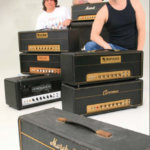
It was originally built around the design of one of Jim Marshall’s favorites, the Fender Bassman; like the Bassman, the JTM45 was actually a fantastic guitar amp. Because of its consistent popularity, Marshall has offered a reissue version of the head — more than 20 years after production of the original JTM45 ceased. While the reissue is built with modern components and assembly techniques, it retains much of the tone, responsiveness and character of the original, hand-wired versions of the early days. No wonder builders today still carry on the tradition of the JTM45, and guitarists continue to seek out the pure simplicity and touch response of this tone machine. To celebrate the JTM45, I got together with my Sunday afternoon amp group, after contacting a handful of respected amp builders who sent us their versions of the amp. We fired them all up alongside an original and a reissue JTM45 to take a listen — and to enjoy one of the best amps ever designed.
About the Authors
About 5 years ago, while playing a 9/11 benefit show, I had the good fortune to meet two people who would not only profoundly impact my life with tube amps, but would become lifelong friends. John Rossi and Tony Burns were there that day; Tony, a killer player and a regular on the Tempe/Phoenix music scene, and Johnny, his friend and amp tech, making sure Tony’s amps were running well in 115 degree heat at the outdoor amphitheater. When I saw Tony’s wall of Marshalls next to my backline of Marshalls, it was an instant conversation starter.
We spent time between sets that day discussing the various finer points of our amps and gawking at each other’s rigs. The show went great but my ’67 Super P.A. felt a bit stiff, and wasn’t reacting in the most flattering way. This incident proved to be the catalyst, as Johnny was an underground semi-retired tech and ultra-fanatic Marshall enthusiast, and he had some ideas that he wanted to try out. He invited me over the following Sunday to check out the amp, and to experiment with various preamp and power amp tubes while BBQ-ing and having a beer. Tony was there, and it became clear that we all had a deep respect for these amps; rather than modify them, we wanted to bring them back to their former glory. After five years, and dozens of hacked-up Marshalls coming back from the dead, here we are. Over that time we’ve learned more about these amazing amps than any of us ever anticipated, and we’ve have had a blast in the process. I have no doubt in my mind, based on my readings of the various amp forums, that there are plenty of groups just like us all over the world doing the same thing.
The Lineup
The lineup consisted of our own 1965 original and 1990 reissue heads, two MetroAmp JTM45s (a kit version as well as the GPM 45), a Germino Classic 45, a Wallace Amplification BKW45 and Mojave Ampworks’ new Special Edition Plexi 45 head. After searching through our collection of cabinets, we settled on both an eighties Marshall JCM800 4×12 with black back 25s, and a Mojave 2×12 cab with 1963-era Celestion Alnico Blues. It may sound strange that there were no pinstripe or basket weave cabs used for the roundup, but that wasn’t for lack of trying. Among all the members of the amp group, we actually have a pinstripe, a basket weave and a variety of Marshall 4x12s, but for some reason we always come back to the early-eighties JCM 800 cab with black back 25s.
That particular cab has more clarity, tone and authority than any other, and it remains our favorite in the bunch — despite the cool factor of the older cabs. The 2×12 with Blues was a natural choice, as that flavor shares similarities with the mid-sixties Marshall cabs and is also a popular speaker configuration for Bluesbreaker combos. The guitars we used were our standard array of Les Pauls from the ’70s, ’80s and 2000s, as well as a newer 2008 Fender Strat and two early-seventies Strats. With everything in the room (it was quite a sight!) we were ready to begin.
 Original 1965 JTM45
Original 1965 JTM45To get our ears accustomed to the JTM45 sound, we began by firing up our ’65 head with a Les Paul. Normally, this head has EL34s in it, but we borrowed the Genelex KT66s from the Mojave and biased the amp to accommodate them. It made sense to us to use KT66s, because they were what the amp was designed for. With everything looking good, we flipped it from standby and beheld the beauty of this vintage masterpiece. It’s no wonder players and collectors are paying big bucks for these amps; everything we played through it sounded incredible.
What was amazing was how much of a rock ‘n roll amp this really is. Considering how long it’s been since it was conceived, the amp’s sound remains surprisingly current. The distortion is organic, full-bodied and earthy, and it allowed the personality of the guitar and player to shine through. While it was very easy to play, this is an amp that still requires a level of discipline and control to fully harness its capabilities. It makes sense that players who want to be heard would play on this style of amp, because like it or not, whatever you play through the amp is… well, amplified. It just comes out better.
We played through it for a good long time, switching guitars and speaker cabinets to hear it in as many different configurations as possible. Whether it was a Strat, a Les Paul, a 2×12 or a 4×12, the sound was always remarkable — perhaps the very definition of great tone. Subjective? Yes. Brilliant? Absolutely. Rolling back the volume on the guitars exposed a beautiful clean tone that was harmonically rich and defined, never muddy or dull. Even with the guitar’s volume knob all the way up, the dynamic response of the amp, and the way it musically fed back, was awe-inspiring.
 Once we had established a base tone for comparison’s sake, it was time to play and listen to the other amps. Before I break down each individual amp and builder, I must observe that each and every one of the amps had ridiculously good tone, and they all sounded like JTM45s, but each had its own unique voice. Aside from the reissue Marshall, all of the amps are hand-wired. The reissue Marshall was of PCB-construction, and used the standard parts and components that Marshall was building their amps with during that era. I spoke with Mitch Colby from Korg USA (Marshall’s US distributor), who told me that the reissues have not undergone any significant changes since their reintroduction 20 years ago. While they are using the components that Marshall builds with today, they should yield very similar tones to the earlier reissue amps.
Once we had established a base tone for comparison’s sake, it was time to play and listen to the other amps. Before I break down each individual amp and builder, I must observe that each and every one of the amps had ridiculously good tone, and they all sounded like JTM45s, but each had its own unique voice. Aside from the reissue Marshall, all of the amps are hand-wired. The reissue Marshall was of PCB-construction, and used the standard parts and components that Marshall was building their amps with during that era. I spoke with Mitch Colby from Korg USA (Marshall’s US distributor), who told me that the reissues have not undergone any significant changes since their reintroduction 20 years ago. While they are using the components that Marshall builds with today, they should yield very similar tones to the earlier reissue amps.
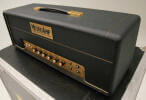 George Metropoulos is no stranger to the world of Marshall amps or to the online amp building community. Having run MetroAmp for some time now, George offers everything from fully built replicas of many classic Marshalls to ready-to-build kits and hard-to-find replacement parts for vintage Marshalls. A player, George honed his amp-tech skills by adopting a DIY approach, taking care of his own amp repairs on the road. This extended into repair work at home, and then really took off when amps began coming in for restoration rather than simple re-tubing. After his ’73 Super Lead was stolen from a gig, he realized it might be best to leave the valuable amps at home, and so he embarked on a never-ending quest to replicate the tone of the old Marshalls.
George Metropoulos is no stranger to the world of Marshall amps or to the online amp building community. Having run MetroAmp for some time now, George offers everything from fully built replicas of many classic Marshalls to ready-to-build kits and hard-to-find replacement parts for vintage Marshalls. A player, George honed his amp-tech skills by adopting a DIY approach, taking care of his own amp repairs on the road. This extended into repair work at home, and then really took off when amps began coming in for restoration rather than simple re-tubing. After his ’73 Super Lead was stolen from a gig, he realized it might be best to leave the valuable amps at home, and so he embarked on a never-ending quest to replicate the tone of the old Marshalls.
Like all the builders in the roundup, George is passionate about vintage Marshalls and obsessive over the details that make these amps so coveted. We received two amps from Metro: the JTM45 kit (which can be purchased already assembled for an additional $400) and the GPM45, George’s custom-built JTM45 using NOS vintage parts. When we fired up the MetroAmp 45s, it was clear that they both came from the same camp. Both amps were meticulously built and incredibly precise in their layouts. The main physical differences between the amps came down to the caps, resistors and tubes. Both amps shared the same iron and layout, so they also shared a lot of the inherent tone in their circuits. As George is a fan of the mid-sixties JTM45s, Metro’s transformers are based on the Drakes, rather than the earlier Radiospares iron [editor’s note: Kit also comes with optional Mercury Magnetics transformers]. Still, there was no question that the GPM45, which included NOS Phillips mustard caps, Allen Bradley carbon comp resistors and a gorgeous set of Genelex KT66s, was sweeter sounding.
While those differences accounted for a tonal upgrade, what made the differences even more compelling was the way they affected the touch factor of the amp. Much like our ‘65, the custom-built Metro had an ease about it that felt like a broken-in vintage head, making it a breeze to dig in, or to lay back on the strings and feel the amp act as an instrument. It was truly inspiring. Of all the amps in the roundup, this amp sounded most like our ’65 — frighteningly close! I should mention that the Metro kit version was actually plugged in first, and before comparing it to the GPM45, we all agreed we’d be thrilled to have one in our collection. We may be splitting hairs here to some degree, but knowing that anyone can buy a complete kit for under a grand, and have that kind of quality and tone — that says a lot.
Metro’s JTM 45 Kit:

Metro’s GTM 45 Custom Build:

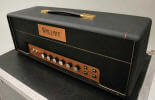 Wallace Amplification BKW45
Wallace Amplification BKW45Brian Wallace has electronics in his DNA. His father, an electronics engineer, and his grandfather, an RCA tube repairman, were both instrumental in his early education and development in tubes and electronics. When he was young his father gave him a 75-in-1 electronic projects kit and further encouraged Brian by letting him watch as he built his own projects. Like all of the builders in the roundup, Brian is a player. He began modifying amps in 1974, when he removed the speakers and baffle in his Checkmate amp and replaced them with a baffle he created and some purchased speakers — altering the sound of the amp and thus beginning his lifelong journey. In 1995, he was approached by Guytron Amplification to help out while they were getting started. A positive experience, it propelled him to the next level and led to the creation of Wallace Amplification, which now offers several amp models as well as replacement transformers under the Marstran name.
Wallace’s first amp is the BKW45, but he is more than a clone maker. Recently he introduced the Abaddon, which is a 50-watt master volume head consisting of four gain stages in the preamp. There is much more to come, including a line of pedals and a reissue of the Fuzz Ace pedal he made back in the early ’90s. The BKW45 is a unique flavor of JTM45. A hair darker in tone and possessing slightly less gain than all of the other models, including both the vintage and reissue Marshall, it yielded enormous bloom and a bold, thick, sustaining quality. Even though there was a little less gain, it didn’t affect playability, and we never struggled with the amp. It was one of the rarest qualities I’ve experienced in an amp, and certainly an unexpected bonus.
 The Wallace had a magical ability to push notes through loud and clear while still being able to dish out gritty and harmonically pleasing chords that didn’t fight the non-perfect intervals they were built on. This all came out of an amp that was using tubes you can buy today without breaking the bank.
The Wallace had a magical ability to push notes through loud and clear while still being able to dish out gritty and harmonically pleasing chords that didn’t fight the non-perfect intervals they were built on. This all came out of an amp that was using tubes you can buy today without breaking the bank.
Speaking of breaking, check out the sidebar on what the BKW45 was subjected to by UPS en route to our roundup. In spite of the gorilla treatment it received, the amp arrived without shattered glass and performed flawlessly throughout the entire set of three sessions of playing and listening. That’s a testament to a solidly built and roadworthy piece of equipment. And one look inside the amp will show what a dedicated and precise builder Wallace is. In tone and build quality, the amp is a work of art.
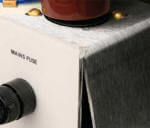 Ever wonder what could happen to your amp in shipping? In the case of Brian Wallace’s BKW45 amp, UPS had a field day, and decided it would be a lot of fun to throw it around. When the amp arrived, it was packed neatly in a new cardboard box with padding inside suspending the padded road case that housed the amp. That’s double-boxed and protected by a case built for heavy abuse. Sadly, it took one good slide down the end of a ramp and collided with either another box or the wall of the truck. Though the box didn’t show any signs of abuse on the outside, it was clear that something had shifted when I opened the case. Take a look at this picture of the damage and the way the entire amp was shifted to one side because of the impact. Believe it or not, the tubes didn’t shatter and the amp worked fine, but it was cosmetically damaged by a broken front Plexi panel. This isn’t the first time this has happened, but it’s the first time I’ve seen it happen with this type of road-worthy packing. Let this serve as a reminder to always insure your amps, as the shipping company can’t tell if you’ve got a bag of peanuts in a box or an amp that was lovingly built by somebody like Brian.
Ever wonder what could happen to your amp in shipping? In the case of Brian Wallace’s BKW45 amp, UPS had a field day, and decided it would be a lot of fun to throw it around. When the amp arrived, it was packed neatly in a new cardboard box with padding inside suspending the padded road case that housed the amp. That’s double-boxed and protected by a case built for heavy abuse. Sadly, it took one good slide down the end of a ramp and collided with either another box or the wall of the truck. Though the box didn’t show any signs of abuse on the outside, it was clear that something had shifted when I opened the case. Take a look at this picture of the damage and the way the entire amp was shifted to one side because of the impact. Believe it or not, the tubes didn’t shatter and the amp worked fine, but it was cosmetically damaged by a broken front Plexi panel. This isn’t the first time this has happened, but it’s the first time I’ve seen it happen with this type of road-worthy packing. Let this serve as a reminder to always insure your amps, as the shipping company can’t tell if you’ve got a bag of peanuts in a box or an amp that was lovingly built by somebody like Brian.
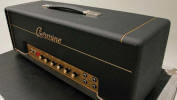 Germino Amplification Classic 45
Germino Amplification Classic 45Greg Germino is another lifelong guitarist who was bitten by the tube-amp bug after catching the Allman Brothers Band back in 1972. He was so inspired by that show that he switched over from acoustic to electric guitar and began taking electronics classes in high school. In 1979, he requested schematics from both Ampeg and Unicord (Marshall’s US distributor at the time) and began his hands-on education with tube amps. He spent the ’80s at an electronics job, and by the early ’90s he was moonlighting doing tube amp repair for a few music stores. He continued to play live with both 50W and 100W Marshalls during that time and moved to Durham, NC to work at Bull City Sound — working on tube amps from the big-name amp companies.
This led to Greg’s being commissioned by Mojo Musical, where he built their Tone Machine amplifier. The following year, 2002, he began work on the prototype of his Lead 55 amp, which debuted in May of 2002. The Classic 45 model is based on the earlier Radiospares-style output transformer, rather than the Drake 1202-103used in the ’65-’66 era, and the circuit is exactly what you would find in an earlier original. The Radiospares-style OT is supplied by none other than Chris Merren, who is highly regarded in the world of Marshalls, and known to make some of the most accurate transformer replicas out there.
 The Classic 45 was the only amp in the roundup that used 6L6 power tubes. Greg’s decision to use them was a combination of staying true to the earliest tubes Marshall used on the original JTM45 amps and his belief that the current crop of 6L6s sound and perform better than newer KT66s. NOS and vintage 6L6s are also less expensive and more plentiful than NOS KT66s. Our immediate response to the Classic 45 was that it was a lively and aggressive amp, with tons of power that made the pick explode off the strings. In ways it reminded us of our favorite ’67 Super Bass in its volume and attack, but it still retained the sound of a 45. It may very well have been the loudest amp of the bunch, and that volume translated to a feeling of excitement that made the amp extremely fun to play. It was present without being shrill and had a super-tight bottom end, no matter what guitar we played through it. While the Classic 45 had tons of natural gain on tap, it also cleaned up nicely when rolling back the volume on the guitar, revealing a bright and sparkly chime. This amp is a real beast, and it could hold its own against 100W amps without flinching.
The Classic 45 was the only amp in the roundup that used 6L6 power tubes. Greg’s decision to use them was a combination of staying true to the earliest tubes Marshall used on the original JTM45 amps and his belief that the current crop of 6L6s sound and perform better than newer KT66s. NOS and vintage 6L6s are also less expensive and more plentiful than NOS KT66s. Our immediate response to the Classic 45 was that it was a lively and aggressive amp, with tons of power that made the pick explode off the strings. In ways it reminded us of our favorite ’67 Super Bass in its volume and attack, but it still retained the sound of a 45. It may very well have been the loudest amp of the bunch, and that volume translated to a feeling of excitement that made the amp extremely fun to play. It was present without being shrill and had a super-tight bottom end, no matter what guitar we played through it. While the Classic 45 had tons of natural gain on tap, it also cleaned up nicely when rolling back the volume on the guitar, revealing a bright and sparkly chime. This amp is a real beast, and it could hold its own against 100W amps without flinching.
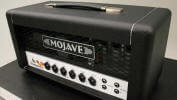 Mojave Ampworks Special Edition Plexi 45
Mojave Ampworks Special Edition Plexi 45Anyone familiar with the JTM45 would surely be jealous of Victor Mason. Not only has he seen more than his fair share of vintage Marshall, Vox, Hiwatt and other rare treasures come through his shop, but Victor recently acquired 26 of the all-time greatest JTM45s ever assembled via the Kronemyer collection, and he’s got the pictures to prove it! This is just one of the factors contributing to the obsessive nature of Mojave (and the associated Plexi Palace). Having been around for over a decade on the internet, Vic has been repairing, restoring, buying and selling vintage Marshalls for quite some time now. Stemming from his early desire to find out how EVH created the classic brown sound, Victor embarked on his journey through countless hours of digging into vintage amps and learning where their strengths and weaknesses lay. Mojave now offers an entire line of amps to serve the classic Marshall tones and well beyond with innovative features and designs. The Mojave Plexi 45 also has two very unique features over a stock JTM45. First is a simple feature to allow volume control by way of throttling the power level. Second is a line level output, which is adjustable and incorporates a ground lift.
Standing apart cosmetically from the rest of the amps, the Special Edition Plexi 45 is built on the same footprint as the Coyote and Scorpion designs, with a white-and-black color scheme and chrome hardware. The head is built with an open grille cage that allows for maximum airflow to keep the set of completely NOS glass cool. The 45 supplied for the roundup consisted of a pair of 1970 NOS Genelex KT66s, 3 Mullard 12AX7s and a Mullard GZ34. Like the Germino, the Plexi 45 is based on the Radiospares transformers, which are custom wound by Mercury Magnetics.
 The chassis is a thing of beauty; the .09″ thick aluminum, with a high tensile strength and welded edges and seams will ensure it will not flex, bend or develop fatigue, like the early, folded, softer chassis, and will prevent the heavy transformers from causing the chassis to sink in and sag. Mojave deviates from the original JTM45 by using modern, tight-tolerance parts. Custom manufactured caps and metal film resistors allow each amp to sound as close to the one built before it as the one after it. Consistency is something that Vic definitely strives for, and it shows in the build quality and attention to detail, and the desire to add convenient functionality to his amps.
The chassis is a thing of beauty; the .09″ thick aluminum, with a high tensile strength and welded edges and seams will ensure it will not flex, bend or develop fatigue, like the early, folded, softer chassis, and will prevent the heavy transformers from causing the chassis to sink in and sag. Mojave deviates from the original JTM45 by using modern, tight-tolerance parts. Custom manufactured caps and metal film resistors allow each amp to sound as close to the one built before it as the one after it. Consistency is something that Vic definitely strives for, and it shows in the build quality and attention to detail, and the desire to add convenient functionality to his amps.
We found in testing that not only did the amp have an extremely low noise floor, but that it was an authoritative and powerfully voiced amp. There was definitely something different in the tone of the Plexi 45; it was cleaner sounding, but still very bold. Having been to Vic’s shop, I was fortunate enough to play one of the 26 JTM45s he had acquired, and I’m positive that the experience with those amps had more than a little to do with the design of the custom Mercury Magnetics’ Radiospares transformers made for his Special Edition model. The amp is built like a tank.
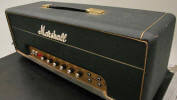 Marshall Reissue JTM45
Marshall Reissue JTM45While the reissue looked very similar to the ‘65 on the outside, especially due to the fact that it’s already 20 years old, the differences on the inside were quite pronounced. Assembled with more modern methods, and using a PCB rather than hand-wired turrets, you could easily be fooled into thinking that it wouldn’t perform like the others. This particular amp was the only one in the bunch to use EL34s rather than KT66s or 6L6s, so the sound was definitely different. It was incredibly loud and focused sounding, and actually had many of the characteristics of a Super Lead. The sustain and power of the amp was incredible, and for an amp that can be found used for around $1000, this is a sleeper bargain. Marshall has taken some flak for their amps sounding stiff and cold from the factory, but with a little attention — slightly hotter bias and good tubes — this amp is a monster. And just because it says it’s a 45-watt amp, don’t harbor any illusions that it would be a good bedroom amp. This is a loud and powerful beast, and a tone machine as well.

The Blindfold Test
As a final, fun test, we did a blind study, to see how accurately I could identify each of the various amps in the roundup. Johnny and Tony set up the group of amps, and I sat in a chair with my back turned away from them. With the guitar plugged in, they began to fire up the various amps, and we got rolling. Out of all the amps, I was always able to distinguish the Wallace BKW45, due to it’s slightly darker sound. The Metros were also fairly easy to spot, but I ended up guessing the kit as the custom build and vice-versa. The ‘65 was also an easy amp to recognize, but as ear-fatigue set in, the lines began to blur substantially. Pretty soon, I was confusing the Germino for the reissue JTM, the Mojave Plexi for the Wallace, and the Metros for the real JTM. It just goes to show you that all of the amps performed remarkably well, and you can be fooled when you’re not seeing what you’re playing, so never discount a PCB reissue head as a second fiddle to the real thing. In the mix of a band, these differences become small, and any one of these amps would hold their own any day of the week.
Wrapup
To have the opportunity to play through so many variations on a classic theme was not only fun, it was educational. Each one of the builders excels in creating their own unique version of the great rock and roll amp that Ken Bran, Dudley Craven and Jim Marshall built back in 1962. While like all Marshalls, the JTM45 went through changes in tubes, components and designs over its lifetime, there is a trademark flavor and color that still can be found in all of them. Not everyone can afford a vintage 45, but with the help of these builders we have the opportunity to get into that sound and have build quality that will last for years.
Source: https://mercurymagnetics.com/pages/news/PremierGuitar/PremierG-20.htm

Some interesting discoveries were made during the course of our research, development and playing a whole bunch of the original Marshall JTM-45 amps to help us achieve our benchmark ToneClone transformer series for this mighty amp.
Many thanks also to our player and collector friends for loaning us their amps and offering their insight for the cause. Many hours of tasty licks included. Incidentally, we do actually own one of the first coffin logo offset chassis amplifiers built by Mr. Marshall and crew.
There are more JTM-45 amps built using EL34 tubes than with the legendary KT66 tubes and there is nothing wrong with that. But a change of tube type also requires swapping out the output transformer to get the correct operating impedance and tone.
All of the original (limited run) handmade amps had 6L6, 5881 or KT66 tubes connected to a Radiospares “De Luxe” output transformers. The “De Luxe” model being the premium offering followed down by the “Heavy Duty” and “Hygrade” models. Primary impedance was selected at 6.6K.
The Bluesbreaker’s legendary tone was made by using KT66 tubes and Radiospares (RS) premium transformers. The transformers did most of the work here with their unique high primary inductance and low leakage inductance combined with padded (surplus) primary impedance as compared to Fenders of the time.
Note: With the exception of the transformers the JTM was a copy of the Bassman. An interesting discovery came to our attention here. It seems that most of the amps made during that era had the output leads connected in reverse phase (backwards). Was it by intent or a happy accident? We and a number of pro players seemed to prefer the reverse phase connection after many A/B tests. We had the impression that the speaker cabs sounded better, more articulate.
When the JTM-45 went into full production, the KT66 tubes were switched for EL34s and the Radiospares transformers were replaced with Drake transformers (judging by build quality and style). All to save BIG on costs since at the time Marshall was being hammered by a distribution deal that shot up retail prices for his amps right through the roof (a deal Jim Marshall later regretted). The EL34s were decent sounding tubes, but the new transformers (not so Bluesbreaker-ish) bore no resemblance to the original RS designs. These simplified transformers had a primary impedance of 3.4K with a much more simple (lower labor cost) design.
The bonus here, though, was in the easier to hook-up speaker connections for the player on the road, which also made it more difficult to connect speakers to the amp in reverse.
Another interesting piece of historical data is that when the EL-34 started earning the reputation as an affordable, reliable and great-sounding tube, the people at Radiospares added it to their compatible list of tubes for the RS “De-Luxe” output without changing the 6.6K impedance. And the EL34 still sounds great through the RS output transformer!!
Source: https://mercurymagnetics.com/pages/_misc/FAQ.htm#EARLY_MARSHALLS
Radiospares — leads — 8k primary — standard RS secondary
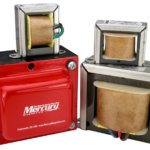
It doesn’t take too much digging to find a laundry list of boutique amp builders using Mercury Magnetics transformers in their products. From Mojave Ampworks to Joe Morgan Amps to kits from MetroAmp, builders have found that Mercury knows their iron. While transformers rarely receive the same level of attention of NOS tubes, speakers, or even guitar cables, they are a major contributor to tone. Think about it—the power and output transformers are the start and end of the line with any amp.
Based in Chatsworth, California, Mercury Magnetics has been building transformers for close to 60 years. I recently had a chance to talk with Mercury’s Sergio Hamernik to dig deeper into their roots, find out what one can expect from upgrading their iron, and what sets Mercury apart. Prior to our conversation, I had the opportunity to witness the remarkable transformation of an Epiphone Valve Junior modified from stock to hot-rodded, using one of their transformer upgrade kits. Not only was it a noticeable upgrade, it was a revelation in just how important the role of quality iron in an amp is. But because it is the single most expensive part of any amp, it’s no wonder we see so many modern amp manufacturers skimp on the iron to keep costs down. Let’s see what the passionate, and often hilarious, Sergio has to say about his part of the business.
I’ve been seeing Mercury transformers in amps for at least a decade. When did you get into the amp scene?
This happens to be one of our most often asked questions. Even though Mercury Magnetics’ roots go all the way back to the early 1950s, there are guitar players who are only now discovering us. But if an industry insider like you has been aware of us for at least a decade, then I suppose it means I don’t need to lay off any of our sales and marketing staff.
I would attribute most of our lingering anonymity to the old days. Back then, most of our clients from the audio community preferred to keep us as a trade secret from their competitors and the press. The typical transformer-savvy amp builder also didn’t usually want to share the credit with us, or reveal what their “unique” technical advantage was regarding audio and tone. Consequently, we were asked to maintain a low profile and generic look for our transformers for quite some time. On occasion, a customer in the know will spot a small “MM” mark on a transformer from an older piece of gear, and ask if it’s a Mercury. Odds are that it is.
It was the guitar amp crowd that pushed us to go above ground. Now Mercury gives any electric guitar player or amp restorer a taste of what the pros were using, talking about in their studios, and amongst themselves. Many players have told us their amps increased in value when upgraded with Mercury transformers, and this became evident when insurance appraisers began to contact us for verification. However, it wasn’t until the mid-1980s when we began to market our services and various brands to guitar players.
For me personally, I got into the amp scene around the mid- to late 1970s. I just found it to be a nice way to relax from the strain of oversleeping.
Your website shows a large number of amp manufacturers you have replacement/upgraded transformers for. What are your best sellers and why?
There are so many different camps loyal to their particular amp brand, so it would be difficult to single out the best sellers. The best sellers are transitory and change from week to week because guitar amp players are a fickle bunch. That’s why we’ve built the world’s largest catalog of guitar amp transformers where nobody is left out.
But trends tend to follow their own dynamics. And the current worldwide trend seems toward smaller wattage amps—regardless of brand. Conversely, the 100-watt heads are not selling like they used to. Players are gigging with no more than 15 watts and a few pedals. Regardless of playing style, they’re doing just fine abiding by sound level restrictions and kicking ass with the tone we feel Mercury upgraded amps deliver.
These players really get the fact that an amp lacking in tone can’t be fixed with higher power or covered up with a gain mod. An amp that coughs out an asthmatic tone at 50 or 100 watts easily fatigues both music listeners and guitarists. But the audience will stay until the bar closes if the band plays well and sounds great—even with as little as a few watts going through the available PA system.
What can a guitarist expect to hear when upgrading their transformers in a newer amp?
An amp’s transformers are the most important component in determining the quality of amplified guitar tone. And it’s no coincidence that they’re the most expensive parts in an amplifier. Many of the newer amps just don’t have the same “overkill” factor with their transformers as the amps in the ’50s and ’60s. Why? Ignorance and a bean-counter mentality. What’s good for accounting isn’t necessarily good for tone from an amp. Sadly, the people making these decisions are probably not players themselves and don’t seem to realize the damage they’re doing to the industry.
It’s not unusual to find a current production amp with a power transformer running hotter than hell, even without cranking the amp all the way. Or having an undersized, cheaply built output transformer whose sphincter begins to tighten the moment the guitarist reaches for the amp’s volume knob. An amp built around anemic transformers yields only to dull, thin, noisy, fuzzy mids and mushy bass. That’s what makes your notes sound more like farts through a pillow. This overkill factor is probably the only edge that some of the vintage amps have over the newer amps.
We have made it our mission to duplicate the performance of the best original transformer designs of all time. In terms of amplified guitar tone history, these transformers represent the best ever produced. – Sergio Hamernik
Have you ever noticed how most newer amps often weigh less, sometimes a lot less, than the older ones? That’s usually the weight difference between the old and new transformer designs. There is a direct relationship between weight and having transformers that seem to stay cooler and “loaf around” with power to spare, until a player demands more from their amp. It’s like they are waiting around having a card game, waiting for the player to do something. The best vintage tone was born that way. Newer amp tone can be easily improved—if the builder follows some of the same ideas.
Upgrading with quality transformers gives a second chance to a new amp owner to make things right with their tone, by reclaiming that overkill factor. Assuming there are no issues with the amp’s circuitry like bad parts or worn out tubes, a guitarist should hear and feel improvements with the very first pluck of the guitar. They should expect to hear the notes more detailed with overtones, and a quicker and more immediate response to their playing. Clean notes will have less sonic collisions with noise and reveal more bell tones, chimes, etc.
When more distortion is required, the player will sense better control of crunch and when break-up begins to happen. The coughing and hacking that happens when a stock amp is pushed, will vanish with a transformer upgrade. It will be replaced with longer sustains and notes that reach farther. The amp will also sound closer and bigger than the power it puts out—and the bass notes will have a tighter, rounder bottom end. And when pushed, she will still be able to hold that quarter from dropping—no matter how tall her high heels—something most musicians are looking for.
It’s not uncommon for guitarists to report that it took a few weeks of playing to fully realize what they’ve gained in terms of harmonic richness. These players have typically played longer and felt more inspirational emotions sucking them in, as they have invested more time into relearning and becoming reacquainted with their amps.
Many players become very attached to the transformers in their vintage amps. When you create ToneClones or Radiospares and Partridge versions of these classic transformers, how close are they get to the originals?
Radiospares and Partridge are our brand specific clones, whereas ToneClones are “best-of-breed” duplicates culled from the hundreds of other brands that have made transformers over the years.
We have made it our mission to duplicate the performance of the best original transformer designs of all time. In terms of amplified guitar tone history, these transformers represent the best ever produced. In the grand scheme of tone pursuit, these designs are incredibility important and deserve to be considered treasures.
This is an ongoing project for us, spanning almost three decades now. And it couldn’t have been accomplished without the enormous amount of assistance we’ve received from top players and amp collectors around the world.
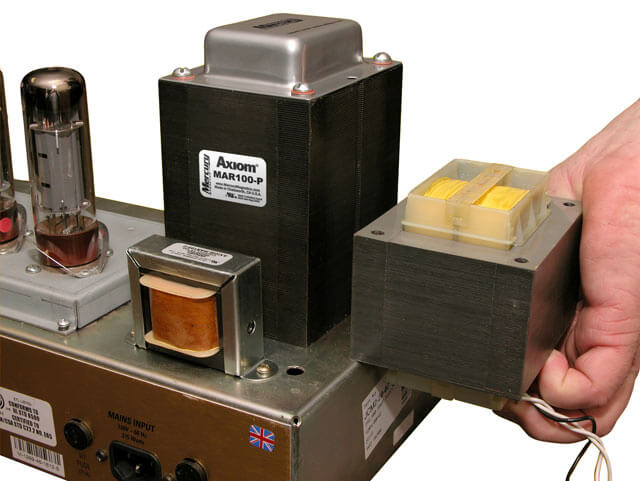
What about Axiom transformers? Where do they fit in?
The Axiom transformer line takes over where the limitations of vintage transformer design ended. No bean counters here—simply the sincere pursuit of answering the age-old question: What if there were no constraints on budget, time, or material quality to achieve the best possible performance? That’s our objective with the Axiom line.
Axiom transformer designs represent many new approaches—new tone with the best materials and designs money can buy, so they’re not intended for the timid or the low-budget crowd. Check out our FatStacks and SuperStacks for the Marshall DSL and TSL families for interesting comparisons.
Mercury’s vintage transformer restoration service has been gaining a reputation for quality work. Why would someone want to restore a transformer instead of replacing it? And vise-versa?
Some vintage amp owners prefer to pay the extra cost of our restoration services, because it’s very important to them that their amps retain authenticity. Collectables or rarities are valuable. They’re of the “why take chances” mind. The high road. But on the flip side, we have pro musicians who insist on touring with their vintage gear. To play it safe, and not sacrifice the tone of their original transformers, they have their techs replace the stock transformers with Mercurys. By doing this, they preserve the original transformers from road abuse while taking advantage of our reputation for tone, durability, and warranty. Restoration of vintage transformers is a tricky and highly specialized art. Sadly, too many of the great originals have been lost forever due to technically inept and musically disinterested people. We see attempts at “rewinds” here all the time.
Occasionally, it appears some people confuse “demolition” with “restoration,” and the preservation of the original tone is lost forever. There’s no shortcut to doing a proper restoration.
I understand you’re doing all of your labor and get all of your materials in the USA. How does that impact your business aside from just the straight costs?
Well, we figured that someone has to do it—and we really do make everything here with 100 percent American materials. There are plenty of products out there stamped with “Made in the USA,” but are actually assembled with non-USA, low-price materials. But yeah, we’re the real deal and proud of it.
Building transformers that make an amp sound good requires highly specialized technologies, highly skilled labor, and the right kind of materials. We love music and owe it to the players out there to do all the work “in-house,” so we can keep tight control over every aspect of our transformer designs. It’s really old-school military spec style, so our transformers don’t vary at all from batch to batch. If you need a replacement transformer 10 years from now, it’ll sound exactly the same as the one it’s replacing.
We’re hard-liners when it comes to not playing shell games with a musician’s hard earned dough and quest for better tone. Perhaps I’m a fool for doing it this way, but I was brought up in a musically minded family. From a very early age, I was taught that music is as important and necessary as food. If there is a day our services are no longer needed or appreciated, I’ll pursue my dream of owning a car wash in the valley, and get into the business of making money.
Any new or exciting projects in the works at Mercury?
Yes, but we’re planning on releasing the news sometime around summer. For quite some time, we’ve been fielding requests for accessories to accompany our transformer line. We’re being asked to apply our know-how to other aspects of guitar amps.
Do you have any advice for guitar players and techs in their quest for tone?
Don’t let anybody fool you—every player has the ability to discern the difference between good or bad tone. Unfortunately, there are a few too many self-styled “experts” who irresponsibly dispense advice without having a clue. As a result, we’ve all seen amps completely lose their tone by being modded to death.
There’s no excuse for the old “damn, I’ve done it this way for many years so it must be right” mentality. More than ever, it’s so easy to seek opinion, advice, and help online and elsewhere. I highly recommend the old textbooks from the 1950s and 1960s as a good place to start on vacuum tube audio circuits.
Do your homework and follow what the smart players are doing—improving your tone isn’t that elusive. If what you have sounds good to you, leave it alone. But if you know your amp’s tone could use some improvement, then start where it begins … the transformers.
Source: https://www.premierguitar.com/articles/Builder_Profile_Mercury_Magnetics

It doesn’t take too much digging to find a laundry list of boutique amp builders using Mercury Magnetics transformers in their products. From Mojave Ampworks to Joe Morgan Amps to kits from MetroAmp, builders have found that Mercury knows their iron. While transformers rarely receive the same level of attention of NOS tubes, speakers, or even guitar cables, they are a major contributor to tone. Think about it—the power and output transformers are the start and end of the line with any amp.
Based in Chatsworth, California, Mercury Magnetics has been building transformers for close to 60 years. I recently had a chance to talk with Mercury’s Sergio Hamernik to dig deeper into their roots, find out what one can expect from upgrading their iron, and what sets Mercury apart. Prior to our conversation, I had the opportunity to witness the remarkable transformation of an Epiphone Valve Junior modified from stock to hot-rodded, using one of their transformer upgrade kits. Not only was it a noticeable upgrade, it was a revelation in just how important the role of quality iron in an amp is. But because it is the single most expensive part of any amp, it’s no wonder we see so many modern amp manufacturers skimp on the iron to keep costs down. Let’s see what the passionate, and often hilarious, Sergio has to say about his part of the business.
PG: I’ve been seeing Mercury transformers in amps for at least a decade. When did you get into the amp scene?
SH: This happens to be one of our most often asked questions. Even though Mercury Magnetics’ roots go all the way back to the early 1950s, there are guitar players who are only now discovering us. But if an industry insider like you has been aware of us for at least a decade, then I suppose it means I don’t need to lay off any of our sales and marketing staff.
I would attribute most of our lingering anonymity to the old days. Back then, most of our clients from the audio community preferred to keep us as a trade secret from their competitors and the press. The typical transformer-savvy amp builder also didn’t usually want to share the credit with us, or reveal what their “unique” technical advantage was regarding audio and tone. Consequently, we were asked to maintain a low profile and generic look for our transformers for quite some time. On occasion, a customer in the know will spot a small “MM” mark on a transformer from an older piece of gear, and ask if it’s a Mercury. Odds are that it is.
It was the guitar amp crowd that pushed us to go above ground. Now Mercury gives any electric guitar player or amp restorer a taste of what the pros were using, talking about in their studios, and among themselves. Many players have told us their amps increased in value when upgraded with Mercury transformers, and this became evident when insurance appraisers began to contact us for verification. However, it wasn’t until the mid-1980s when we began to market our services and various brands to guitar players.
For me personally, I got into the amp scene around the mid- to late 1970s. I just found it to be a nice way to relax from the strain of oversleeping.
PG: Your website shows a large number of amp manufacturers you have replacement/upgraded transformers for. What are your best sellers and why?
SH: There are so many different camps loyal to their particular amp brand, so it would be difficult to single out the best sellers. The best sellers are transitory and change from week to week because guitar amp players are a fickle bunch. That’s why we’ve built the world’s largest catalog of guitar amp transformers where nobody is left out.
But trends tend to follow their own dynamics. And the current worldwide trend seems toward smaller wattage amps—regardless of brand. Conversely, the 100-watt heads are not selling like they used to. Players are gigging with no more than 15 watts and a few pedals. Regardless of playing style, they’re doing just fine abiding by sound level restrictions and kicking ass with the tone we feel Mercury upgraded amps deliver.
These players really get the fact that an amp lacking in tone can’t be fixed with higher power or covered up with a gain mod. An amp that coughs out an asthmatic tone at 50 or 100 watts easily fatigues both music listeners and guitarists. But the audience will stay until the bar closes if the band plays well and sounds great—even with as little as a few watts going through the available PA system.
PG: What can a guitarist expect to hear when upgrading their transformers in a newer amp?
SH: An amp’s transformers are the most important component in determining the quality of amplified guitar tone. And it’s no coincidence that they’re the most expensive parts in an amplifier. Many of the newer amps just don’t have the same “overkill” factor with their transformers as the amps in the ’50s and ’60s. Why? Ignorance and a bean-counter mentality. What’s good for accounting isn’t necessarily good for tone from an amp. Sadly, the people making these decisions are probably not players themselves and don’t seem to realize the damage they’re doing to the industry.
It’s not unusual to find a current production amp with a power transformer running hotter than hell, even without cranking the amp all the way. Or having an undersized, cheaply built output transformer whose sphincter begins to tighten the moment the guitarist reaches for the amp’s volume knob. An amp built around anemic transformers yields only to dull, thin, noisy, fuzzy mids and mushy bass. That’s what makes your notes sound more like farts through a pillow. This overkill factor is probably the only edge that some of the vintage amps have over the newer amps.
We have made it our mission to duplicate the performance of the best original transformer designs of all time. In terms of amplified guitar tone history, these transformers represent the best ever produced.—Sergio Hamernik
Have you ever noticed how most newer amps often weigh less, sometimes a lot less, than the older ones? That’s usually the weight difference between the old and new transformer designs. There is a direct relationship between weight and having transformers that seem to stay cooler and “loaf around” with power to spare, until a player demands more from their amp. It’s like they are waiting around having a card game, waiting for the player to do something. The best vintage tone was born that way. Newer amp tone can be easily improved—if the builder follows some of the same ideas.
Upgrading with quality transformers gives a second chance to a new amp owner to make things right with their tone, by reclaiming that overkill factor. Assuming there are no issues with the amp’s circuitry like bad parts or worn out tubes, a guitarist should hear and feel improvements with the very first pluck of the guitar. They should expect to hear the notes more detailed with overtones, and a quicker and more immediate response to their playing. Clean notes will have less sonic collisions with noise and reveal more bell tones, chimes, etc.
When more distortion is required, the player will sense better control of crunch and when break-up begins to happen. The coughing and hacking that happens when a stock amp is pushed, will vanish with a transformer upgrade. It will be replaced with longer sustains and notes that reach farther. The amp will also sound closer and bigger than the power it puts out—and the bass notes will have a tighter, rounder bottom end. And when pushed, she will still be able to hold that quarter from dropping—no matter how tall her high heels—something most musicians are looking for.
It’s not uncommon for guitarists to report that it took a few weeks of playing to fully realize what they’ve gained in terms of harmonic richness. These players have typically played longer and felt more inspirational emotions sucking them in, as they have invested more time into relearning and becoming reacquainted with their amps.
PG: Many players become very attached to the transformers in their vintage amps. When you create ToneClones or Radiospares and Partridge versions of these classic transformers, how close are they get to the originals?
SH: Radiospares and Partridge are our brand specific clones, whereas ToneClones are “best-of-breed” duplicates culled from the hundreds of other brands that have made transformers over the years.
We have made it our mission to duplicate the performance of the best original transformer designs of all time. In terms of amplified guitar tone history, these transformers represent the best ever produced. In the grand scheme of tone pursuit, these designs are incredibility important and deserve to be considered treasures.
This is an ongoing project for us, spanning almost three decades now. And it couldn’t have been accomplished without the enormous amount of assistance we’ve received from top players and amp collectors around the world.
What about Axiom transformers? Where do they fit in?
The Axiom transformer line takes over where the limitations of vintage transformer design ended. No bean counters here—simply the sincere pursuit of answering the age-old question: What if there were no constraints on budget, time, or material quality to achieve the best possible performance? That’s our objective with the Axiom line.
Axiom transformer designs represent many new approaches—new tone with the best materials and designs money can buy, so they’re not intended for the timid or the low-budget crowd. Check out our FatStacks and SuperStacks for the Marshall DSL and TSL families for interesting comparisons.
PG: Mercury’s vintage transformer restoration service has been gaining a reputation for quality work. Why would someone want to restore a transformer instead of replacing it? And vise-versa?
SH: Some vintage amp owners prefer to pay the extra cost of our restoration services, because it’s very important to them that their amps retain authenticity. Collectables or rarities are valuable. They’re of the “why take chances” mind. The high road. But on the flip side, we have pro musicians who insist on touring with their vintage gear. To play it safe, and not sacrifice the tone of their original transformers, they have their techs replace the stock transformers with Mercury’s. By doing this, they preserve the original transformers from road abuse while taking advantage of our reputation for tone, durability, and warranty. Restoration of vintage transformers is a tricky and highly specialized art. Sadly, too many of the great originals have been lost forever due to technically inept and musically disinterested people. We see attempts at “rewinds” here all the time.
Occasionally, it appears some people confuse “demolition” with “restoration,” and the preservation of the original tone is lost forever. There’s no shortcut to doing a proper restoration.
PG: I understand you’re doing all of your labor and get all of your materials in the USA. How does that impact your business aside from just the straight costs?
SH: Well, we figured that someone has to do it—and we really do make everything here with 100 percent American materials. There are plenty of products out there stamped with “Made in the USA,” but are actually assembled with non-USA, low-price materials. But yeah, we’re the real deal and proud of it.
Building transformers that make an amp sound good requires highly specialized technologies, highly skilled labor, and the right kind of materials. We love music and owe it to the players out there to do all the work “in-house,” so we can keep tight control over every aspect of our transformer designs. It’s really old-school military spec style, so our transformers don’t vary at all from batch to batch. If you need a replacement transformer 10 years from now, it’ll sound exactly the same as the one it’s replacing.
We’re hard-liners when it comes to not playing shell games with a musician’s hard earned dough and quest for better tone. Perhaps I’m a fool for doing it this way, but I was brought up in a musically minded family. From a very early age, I was taught that music is as important and necessary as food. If there is a day our services are no longer needed or appreciated, I’ll pursue my dream of owning a car wash in the valley, and get into the business of making money.
PG: Any new or exciting projects in the works at Mercury?
SH: Yes, but we’re planning on releasing the news sometime around summer. For quite some time, we’ve been fielding requests for accessories to accompany our transformer line. We’re being asked to apply our know-how to other aspects of guitar amps.
PG: Do you have any advice for guitar players and techs in their quest for tone?
SH: Don’t let anybody fool you—every player has the ability to discern the difference between good or bad tone. Unfortunately, there are a few too many self-styled “experts” who irresponsibly dispense advice without having a clue. As a result, we’ve all seen amps completely lose their tone by being modded to death.
There’s no excuse for the old “damn, I’ve done it this way for many years so it must be right” mentality. More than ever, it’s so easy to seek opinion, advice, and help online and elsewhere. I highly recommend the old textbooks from the 1950s and 1960s as a good place to start on vacuum tube audio circuits.
Do your homework and follow what the smart players are doing—improving your tone isn’t that elusive. If what you have sounds good to you, leave it alone. But if you know your amp’s tone could use some improvement, then start where it begins… the transformers. PG
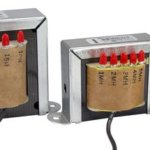
Weber output transformer
All and all not bad. The bottom is a bit boomy but it’s an easy fix. I did have to dial the bass down for the recording. The distortion seems loose and undefined. My dad likes the thickness, but he’s all about some Slow Hand’s “Woman tone.” If you’re on a budget definitely not a bad buy.
Heyboer output transformer
Clean is decent but this is probably my least favorite of the bunch. Way too muddy and grainy when distorted. I don’t like the feel of this transformer, and it has some weird mid-harmonics. It never seemed happy no matter how I set it.
Classic Tone output transformer
Clean is fantastic. Has great rich mids and terrific high-end sparkle but the bass is a bit thin. This transformer has a nice sweet spot but turning the knobs all the way up or down doesn’t have much effect on the sound. So it’s not as versatile as I would have liked. Still a little loose on the distortion but with good clarity. Definitely a great buy.
Hammond output transformer
Great Clean. The controls were very responsive but not what I’m going for with this amp. For whatever reason this pulls out all the Stevie Ray tones. My Tele always sounds like a Strat when using this transformer. It’s nice but not right for this rig. If I build a Fender in the future I might do another shoot out, and Hammond would definitely make the lineup.
Marstran Radiospares output transformer
I played this up a half step… whoops… and I blew fuse at the end of the recording and that’s why the demo is a little shorter than the others. The overall tone is harsh and I couldn’t get it smoothed out to save my life. The highs and mids are really sharp and spikey. The very top is shrill and thin. It also had some strange harmonics that just aren’t pleasant.
Mercury Magnetics Radiospares output transformer
This is by far the most versatile transformer out of the bunch. You can dial this thing any which way and it sounds great. The bass is full but not boomy. The mids are rich and smooth. The highs sing and sparkle but aren’t thin. The harmonics are ideal and even across the board. The distortion is the tightest and no matter how hard the amp is driven each note still has clarity. The touch sensitivity is unreal. With the amp almost dimmed you can play soft and hardly hear any distortion. Then you can bang out a chord or dig into some lead and the amp will scream. Yeah, it may cost four times as much, but as the old saying goes, “You get what you pay for.”
Source: https://mercurymagnetics.com/pages/news/misc/ShootOut.htm
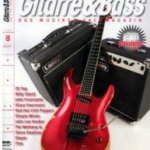
Zitat über Mercury Magnetics bei Boutique Verstärker Seite 139
Diese Transformatoren gehören zu den besten Ausgangsübertragern, die auf dem Markt heute erhältlich sind. Sie werden sehr aufwendig und mit den besten Materialien hergestellt, um so nah wie möglich an die wunderbaren alten Transformatoren der Firma Radiospares aus den 60er Jahre heranzukommen. Der Stahl wird noch von Hand geglüht, im Gegensatz zu modernen Transformatoren, welche eine Silizium-Stahl-Legierung verwenden. Die Sound-Unterschiede sind gravierend.
English translation: “These transformers are known as the best output transformers available on the market today. Their production is very complex and just the best materials are used to reach as close as possible the wonderful old transformers from the company ‘Radiospares’ from the sixties. The steel is still annealed by hand – compared to the modern transformers which use a silicium steel alloy. The sound differences are enormous.”
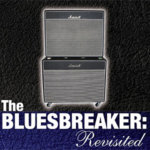
If you want to nail Clapton’s tone, a crucial part of the equation is the amplifier. With a little ingenuity, John Wiley shows you how to turn your reissue Bluesbreaker combo into the real deal.
A unique distinction of early Marshall amplifiers is that none of them within the same model line sound exactly alike. Partly attributable to founder Jim Marshall’s penchant for working with budding British musicians and working many of their suggestions into his designs, and partly due to the difficulties of locating reliable parts suppliers, Marshall’s early designs each had their own personality. For instance, Marshall’s Model 1962 combo was, itself, an ordinary amplifier; however, one particular Model 1962 used by Eric Clapton with John Mayall and the Bluesbreakers had such a revolutionary tone that it created a new sound in the still-young world of rock n’ roll.
In 1965, Clapton found himself the featured guitarist in John Mayall and the Bluesbreakers. Armed with a 1960 Gibson Les Paul and the Marshall Model 1962 combo amplifier, he single-handedly discovered a combination of guitar and amp that produced an extraordinary howl — Clapton achieved his trademark sound by playing the amplifier at full volume. The sound was full-bodied, authoritative, but not overly distorted; it easily cut through the other band instruments. The sustain was pure, the treble notes sang and the bass registers exhibited a “throaty” bottom. At such high volumes, the amp was prone to feeding back, and this provided an awesome effect to the overall sound.

This image, from the Beano LP, shows Clapton tuning up, with his Model 1962 in the background.
The blistering tone was captured on vinyl and released to an unwitting public as John Mayall and the Bluesbreakers with Eric Clapton; also known as the “Beano” album, it quickly shot to number six on the British charts, even amongst the din of other popular British and American pop groups such as the Beatles, the Animals, the Rolling Stones and the Beach Boys. That LP’s impact soon spread to America and abroad, inspiring legions of new guitarists around the world — especially influencing musical rebels in the United States. Clapton’s playing style, combined with a ferocious amplified tone, seemed to inject a new and exciting dimension into the young blues-rock genre. But none of this could have happened without the small British amp company, Vox. Models like the AC30 would provide the “British Invasion” with its unique sound, and convinced Marshall to build a compact amplifier for his new company; the initial development of Marshall’s first combo took place in early 1964. In a 2003 interview with Musician’s Hotline magazine, he claimed the Model 1962 was built at the request of Eric Clapton. “Eric used to practice in my shop and he was one of the first guitarists to ask me to build a combo,” Marshall recalled. “He wanted one so it would be easy for him to put the whole thing in the boot [trunk] of his car.”
Unfortunately, that Model 1962 disappeared, with Clapton himself unsure of what became of it; years later, it would become known as the holy grail of combos. Although those early combos had great tone, no two sound exactly the same. Two decades later, the Marshall reissue would sound nothing like it at all.
The Reissue
For many of us, the year 1990 brought an answer to one of our greatest wishes: the Marshall Model 1962 2×12 combo was finally reissued. The idea had apparently been in the works for quite some time, as evidenced by this author’s correspondence to a Marshall factory director, Keith Carnall in the late months of 1984. Carnall’s reply stated, “We have thought many times about running a ‘vintage special,’ with valve rectification and all the other old goodies… let us just say for now that it is an idea that we will continue to work around and perhaps you will get your wish granted.” Although Clapton was not aware of the amp being reissued, Marshall christened it the “Bluesbreaker,” in his honor. When asked in a 1989 Guitar World interview he replied, “Did they really? How sweet. I didn’t even know that. How does it sound?” Marshall simultaneously introduced the Bluesbreaker and the JTM45 in 1990, along with the new JCM900 series.
At a cursory first glance, Marshall did an outstanding job recreating the Bluesbreaker, as it externally resembled the original with the distinctive and elegant Marshall styling. Just like the original, it was rated at 45 watts and came with two Celestion speakers. The cabinet dimensions measured 29.13″ wide by 23.62″ high by 9.25″ deep, and black vintage Tolex coupled with a vintage-style Bluesbreaker grill cloth completed the package. Electronically, the 1989 reissue used two 6L6 vacuum tubes for power, three ECC83 (12AX7) preamp tubes and one GZ34 rectifier tube. In 1993, Marshall replaced the 6L6s with 5881 vacuum tubes. Tonally, the Bluesbreaker reissue had a unique and fine sound of its own. It produced varying degrees of that buttery smooth sustain, while retaining that traditional Marshall crunch.
The following is a listing of the basic differences between the original Model 1962 and the Model 1962 “Bluesbreaker,” as reissued in 1990:
|
But just how close was this new variant to the original Model 1962? To the true Marshall collector, and to the rare few who actually owned the genuine article, the differences were immediately apparent. In Michael Doyle’s book, The History of Marshall, he pointed out that the cabinet was too small and the grill cloth was not right. But the major disappointment was not in the appearance, but the sound the amplifier produced. While the sound was good and had plenty of Marshall crunch, it was definitely not the sound of the original. And for that reason, I began a quest to change the sound of my reissue into something more closely resembling the original.
Hitting the streets in 1990, the Model 1962 “Bluesbreaker” reissue was plagued with discrepancies out of the box. The cabinet was undersized by some 30 percent, with a depth barely over 9″, while the original measured in at 10.5″. The reissue’s overall width was almost 30″, while the original was 32″. The most reasonable explanation for these differences would come from the use of output tubes originally selected for the Model 1962. Although the very first combos incorporated the smaller 5881 vacuum tube, Marshall designed the Model 1962 for the more prevalent but enormous Coke bottle-shaped KT66 vacuum tube. The usage of this particular tube necessitated the deeper 10.5″ cabinet.
Likewise, the cabinet’s construction differed significantly from original specs. The Model 1962 Series I was built using pine planks for the cabinet with multi-ply birch baffles; the Model 1962 Series II was completely constructed with multi-ply birch plywood (more about these series differences in a moment). The reissue used particle board for the cabinet and plywood baffles.
Finally, the speakers supplied in the original combo were G12M “Greenbacks,” rated at 20 watts each. This speaker utilized an Alnico magnet, providing sweet, warm tones and a smooth midrange — an essential ingredient for that “British chime.” At 20 watts, the speaker could barely keep up with the tremendous overdrive of the amplifier when it was at full volume. Marshall, however, equipped the Bluesbreaker reissue with 25-watt Greenbacks, featuring ceramic magnets. While they lacked the chime of an Alnico magnet, they could withstand twice the wattage and had a fine sound of their own.
The Model 1962 Back Story
However, before we dig in and modify our reissue Bluesbreaker, it would behoove us to understand where it all started. In 1964, while the Beatles made their first appearance on the Ed Sullivan Show, and the Civil Rights Act of 1964 was enacted, Marshall was busy introducing its very first combo. Because it was the very first series, it is historically referred to as the Model 1962 Series I. Interestingly, the 1962’s model number did not refer to a particular year or significant event in time. Until the 1980s, Marshall’s distributor and financial backer Rose-Morris used these numbers arbitrarily, using the prefix “19” for all of Marshall’s product line.
Jim Marshall wanted his new range of combos to be versatile; as a result, he designed the Model 1962 with two 12″ loudspeakers and used the JTM45 bass chassis (Model 1986) electronics. The Model 1962 was described in the Marshall catalogue as a “Bass/Lead” unit, making it an extremely versatile amplifier that could be used by guitarists and bass players alike.
But just how close was this new variant to the original Model 1962? To the true Marshall collector, and to the rare few who actually owned the genuine article, the differences were immediately apparent.
In addition, a second combo with four 10″ speakers — the same configuration used in the Fender Bassman — was offered to players. Marshall’s 4×10 version was referred to as the “Lead” and utilized the JTM45 treble chassis (Model 1987) electronics. This 4×10 configuration, designated the Model 1961, was designed for guitar use only. Both Model 1962 and 1961 were purposely marketed as the British equivalent to the vastly popular Fender Bassman, and they offered quite a bargain for British and European musicians. The Model 1961 retailed for a scant $165 American dollars and the Model 1962 retailed for $170, while the Fender Bassman was nearly double at $300. Both models went into production in late 1964.
Cabinet and Construction
The cabinet dimensions for the Model 1962 (2×12 configuration) were 30″ wide by 24″ high by 12″ deep. The 1961, incorporating four 10″ speakers, maintained square proportions, measuring 28″ wide by 28″ tall and 11″ deep. The Model 1962’s width is 2″ wider and 1″ deeper than the 1961’s to accommodate the dual 12″ speakers.
Marshall amplifiers would also gain a reputation for their ruggedness. Marine ply birch was used for cabinet construction, as the laminated layers of glued veneer plywood provided greater overall strength than a singular plank of yellow pine, which was the wood of choice for Fender amplifiers. These early Marshalls did not use the “finger-lock” joints that would become standard on all Marshall cabinets a few years later.
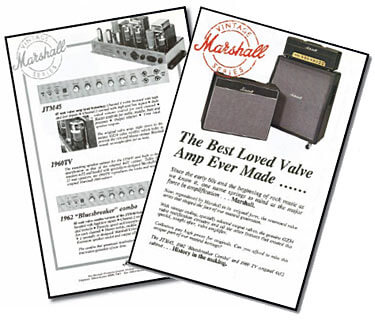
The Marshall ads above suggested the reissues matched the originals; in reality, there were significant differences.
Marshall cabinets were also visually appealing and had the look of richly appointed furniture. Black PVC (polyvinyl chloride) material, similar to the General Tire invention known as “Tolex,” was used for the entire exterior of the cabinet. This smooth, black fabric was different from the black “Levant” Tolex Marshall would use later.
Accenting the cabinets was Marshall’s elegant grill cloth. The company’s catalogue referred to this early cloth only as, “contrasting speaker grills,” not actually describing the color or pattern of the cloth material. However, it was known as the “white” grill cloth and had thin, horizontal gray lines running through it. Also included on the earliest models were three leather straps, attached to the top of the cabinet and similar to the Vox AC30. These amplifiers weighed in at a very heavy 70 pounds, and the sheer weight meant that it wasn’t long before the leather straps would stretch and break. In early 1965, an improved, single plastic strap which was stronger and larger in size replaced the leather ones.
The very first Marshall combos produced in late 1964 used what was known as “Vox-style” cooling vents, which allowed the heat produced by the transformers and vacuum tubes to escape efficiently. Two vents were installed into the top of the cabinet, similar to the Vox AC30. The vents were rectangular in shape and had a metal screen riveted inside.
Chassis Electronics and Components
The internal chassis that included all the electrical components was made of 6061 aluminum sheet metal. Aluminum has excellent non-sparking and non-magnetic characteristics, making it ideal for electrical shielding purposes and chassis use. It is, however, not as strong as steel and would fatigue and sag under the weight of the heavy power and output transformers. To remedy this, cast aluminum end blocks were riveted inside each end of the chassis to add strength and rigidity. The chassis were 2.5″ deep and purchased from a sub-contractor named Smiths.
The JTM45 used one circuit board screwed inside the aluminum chassis, providing a central platform for the various electrical components. Prior to 1965, Marshall used Tufnell perforated circuit boards; from 1965 to 1967 a subcontractor called Heathfield manufactured the circuit boards, which can be recognized by the drilled holes on the solid sheets.
The output transformer was officially known by Marshall as the “RS De Luxe.” It was light gray in color, with horseshoe end bells. The maximum output rating was only 30 watts, and all three transformers used on the JTM45 — the output, power and choke — were purchased from Radiospares, an electrical component clearing house.
The first combos produced in late 1964 were equipped with two GEC (General Electric Co.) KT66 vacuum tubes. The original design of the JTM45 called for the Tung-Sol 5881 tube; because this tube was used in the Fender Bassman, it was the tube of choice. However, supplies for the 5881 were scarce and the KT66 was used as a replacement. The KT66 provided more bite and distortion, suiting the JTM45 perfectly, and unlike the EL34, it was not overly saturated and did not sound mushy. The KT66’s bottom end was solid and exhibited clarity, while the trebles were almost “violinlike” in nature and very smooth. Much like the Fender Bassman, the JTM45 became known for its unique sound, primarily because of this tube.
Four 12AX7 (designated the ECC83 in Europe) preamp tubes were supplied in the 1961 and 1962, and both featured a tremolo circuit as a standard appointment. These amps also included tube rectification, which added to the sound’s overall smoothness. The 5AR4 rectifier tube (designated the GZ34 in Europe) was used on all JTM45 configurations, including models 1961 and 1962, and was the same rectifier used in the Fender Bassman and many other classic American amplifiers.
The JTM45 also incorporated two “can” style filter capacitors; the number of capacitors used, and their respective value, was a significant factor in the overall sound of the amplifier. One LCR Co. 32ìf x 32ìf at 450 volts was mounted on top of chassis near the power transformer, and one LCR Co. 16ìf x 16ìf at 450 volts was mounted inside the chassis just beneath the power transformer — the standard arrangement for the JTM45.
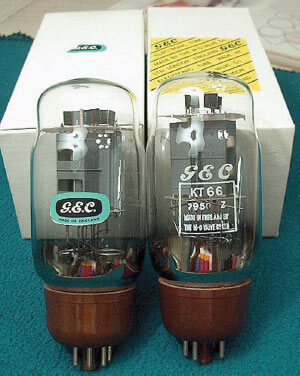
KT66 tubes as were used in Clapton’s Model 1962.
Speakers & Logo
The Model 1961 would utilize four 10″ Celestion Alnico speakers, while the Model 1962 would use two 12″ Celestion G12 speakers, handling 15 watts and featuring an Alnico magnet. The Alnico magnet contributed to the amp’s unique and sparkling sound, referred to as the “British chime.” A basic style of logo badge was used on these very first combos, and is commonly referred to as the “gold block logo.” The badge was rectangular in shape and was very simple, having only the Marshall name in bold block letters. The letters were black in color on a background of gold, although silver was sometimes used.
The Clapton-Spec Combo — One of a Kind?
The particular Model 1962 amplifier that Eric Clapton used with John Mayall and the Bluesbreakers was unfortunately lost, without knowing its exact pedigree. It was definitely an early edition of the Series II combo and was built during a continuous procession of production changes and revisions. The typical production run of any of the Marshall line could have differing components from amp to amp — it is not an exaggeration to say no two amps were exactly alike. This was primarily due to the inconsistent component suppliers Marshall used at the time, and partly because booming business made record keeping (serial numbers, production quantities, etc.) a low priority — existing serial numbers are not reliable or even logical, and production numbers are at best derived from employee recollections. Therefore, determining just how many amps were built exactly like Clapton’s is extremely difficult. The following list of features, derived from exhaustive research, best represents the Clapton’s combo specs. This particular amp is pictured on the reverse side of the “Beano” LP. The Series II cabinet was designed by Marshall’s chief designer Ken Bran, and incorporated a more modernistic styling. Its dimensions were 32″ wide by 23″ high by 10.5″ deep. The cabinet was sturdy and constructed of 3/4″ marine ply, incorporating one slot-style cooling vent and covered with black Lavent vinyl. The grill cloth was the classic gray and white striped variety later known as “Bluesbreaker” grill cloth. The cabinet was smartly accented with gold hardware attachments for the cabinet handle.
Chassis Electronics and Components
Clapton’s amplifier utilized the JTM45 bass guitar amplifier electronics known as the Model 1986 and the same chassis used in the Series I, made of 6061 aluminum sheet. One circuit board screwed inside the aluminum chassis was used and it was manufactured by the Heathfield Company.
Mounted on top of the chassis was the heart of the amplifier — the transformer. The defacto JTM45 output transformer was the “RS De Luxe;” however, since it was rated at only 30 watts, it was not ideal. Clapton’s amp may have utilized the newly acquired Drake Companytransformers. The output transformer would have been Model #784-103, with an 8K primary Z, and the power transformer would have been Model #1202-55. Utilizing the Drake transformers would explain why Clapton’s combo did not sound like a “typical” JTM45amplifier.
Clapton’s amplifier utilized two GEC KT66 output vacuum tubes. The preamp circuit included four Mullard ECC83 tubes, with one dedicated to the tremolo circuit. The Mullard GZ34 rectifier tube was again used. Two can-type filter capacitors were used: one LCR 32ìf x 32ìf at 600 volts mounted on top of the chassis near the output transformer, and a second LCR 16ìf x 16ìf at 450 volts mounted inside the chassis.
Speakers
The amp’s speakers consisted of two 12″ Celestion G12s, rated at 20 watts, 15 ohms, and with an Alnico magnet. These speakers were essentially the same as those used in Vox AC30s, and are extremely fragile when pushed beyond their limit. Because Clapton ran the amplifier at full volume, the Alnicos may have been damaged. He may have replaced them with the higher wattage, ceramic magnet Celestion Greenbacks.
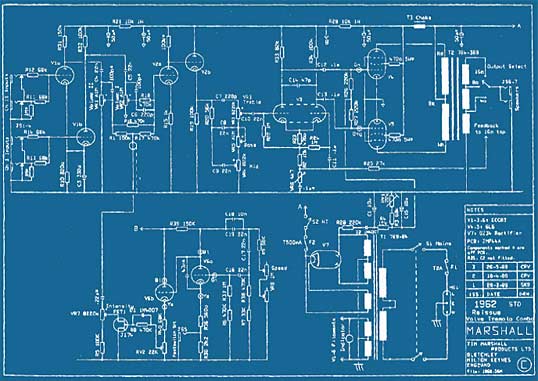
The Model 1962 reissue schematic.
The Objective: Convert a Reissue to Clapton-Spec
I started my investigation into obtaining this sound over 20 years ago. In addition to the “Beano” studio CD, there were other John Mayall albums that included “live” cuts from Eric Clapton’s time with the Bluesbreakers. Although these recordings were done with crude equipment, they captured the raw and unrestrained sound of Clapton’s guitar and amplifier. To my ears, these recordings were most realistic, as they lacked any studio treatment. I quickly knew what sound I was after.
In 1994, Mike Doyle’s book, The History of Marshall, was released and included an eye-opening chapter on the Bluesbreaker. That chapter confirmed the reissue’s lack of authentic sound, and it became obvious that in the amp’s conversion to Clapton specs the only salvageable pieces would be the electrical chassis, the control panel and some of the cabinet hardware — the cabinet and speakers would have to be replaced.
With that, I decided to do the conversion in a logical progression and planned to document the progress. I preferred a progressive approach, as it would give me a chance to analyze each change made separately. In addition, since this conversion would be fairly expensive, it would be easier on the budget to purchase items over a period of time. The changes required could be grouped into three categories:
I should note that it is possible to make deeper changes, such as replacement of the circuit board, resistors, potentiometers and components, plastic tube sockets, and rewiring of the chassis to original specifications. These additions will make the electronics of the amplifier more authentic, but will not noticeably improve the sound. These additions also significantly increase the cost and add more time to the project.
The steps I have outlined above will reproduce the amplifier tone as heard on the live cuts of Clapton with the Bluesbreakers, as well as the “Beano” record. In fact, after making these changes, your Bluesbreaker will no longer be a mere reissue — it will sound like the real thing!

The new cabinet is over 2″ bigger than the reissue cabinet, resulting in a fuller sound.
Step 1: A Bigger Cabinet
There are now several competent amplifier cabinet makers building exact replicas of the Model 1962 Series I and II cabinets. Be sure these makers use the required multi-ply Baltic birch plywood, correct black Tolex covering, vintage gold veining and the surrounding white piping. It is also wise to have them confirm the correct cabinet dimensions, as the Series I and II are two completely different cabinets. To save some money, you could use the Marshall logo, casters and other hardware from your existing reissue. Two excellent cabinet makers available on the internet are Vibroworld.com and Swansoncabinets.com.
For the first phase, I ordered a new cabinet from a cabinet maker on the internet — to ensure accuracy, I supplied them with a CAD drawing of the Series II dimensions and features. I was very pleased with the results I received a few weeks later. I removed the chassis and speakers from my Marshall reissue and reinstalled them in the new cabinet. Even though the new cabinet included pre-drilled holes and Tnuts for the speakers, it still took some time to make this switch. While switching cabinets, be careful to ensure the speaker and amplifier connections are right.
For testing, I used a Gibson Les Paul Heritage 80 model. After re-checking the chassis and cabinet connections, I turned on the amplifier, and let it warm up. I started at low volumes and progressively turned up the volume to 10, all while keeping the other settings such as presence, bass, middle and treble at 10. Upon hearing the first chords, I was immediately struck by a new “openness.” The amplifier seemed to breathe and had a new, airy sound to it — it did not sound as tight as the smaller reissue cabinet. With 30 percent more space in the cabinet than the reissue, the trebles seemed revived and the amp now had an “airy” bottom-end. Comparative testing with another stock Bluesbreaker reissue verified the tonal improvements.
An interesting side note; in 1997, Marshall produced a limited edition white Bluesbreaker called the “Limited Edition 1997.” It was basically was the same amplifier as the 1989 reissue, with one important difference: the limited edition’s cabinet incorporated the deeper 10.5″ thickness, as can be found in the original Model 1962 Series II.
Step 2: The Electronics
Before digging into the guts of the Bluesbreaker, a word of caution: this phase deals with potentially dangerous electrical voltages and it is highly recommended that only a trained and competent amplifier repair person or skilled electrician perform these tasks.
This phase involves swapping out the reissue transformer, changing the 6L6 vacuum tubes to KT66s, and replacing the filter capacitors.
The Transformers and Tubes
There are now some good vintage transformer manufacturers around, so one has a choice in the matter. Since the original Model 1962 used a Radiospares (RS Deluxe) transformer, the objective here is to get one like it. When I did my conversion, I purchased a Mercury Magnetics Model O45RSL-8-M(MercuryMagnetics.com).
When it comes to power tubes, the only one to use here is the revered KT66. There are however, a few brand options available. One could either purchase a matched set (two are needed) of original GECs, or purchase a pair from companies offering reissue KT66s. The European and American tubes manufactured in the 1950s and 60s (new old stock) are superior in tone, quality and reliability. Tubes now manufactured in Russia and China such as Groove Tubes, the new Tung-Sol, and JJ/Tesla offer comparable tone and are reasonably priced. Since these tubes are made overseas, it is difficult to isolate a superior brand, and although tonal quality is improving with better consistency, tone remains an individual choice. For my conversion I used a matched set of Chinese Valve Art tubes, and was not disappointed.
Since we are changing out the power tubes, it is highly recommended to replace the 12AX7 (ECC83) preamp tubes as well. Again, there are several good options here which include SED Winged “C,” Electro-Harmonix and Ei/Ei-Elites. Replacing the GZ34 (5AR4) rectifier tube is also a must for optimum performance. The same tube suppliers listed above carry the GZ34, in varieties like Sino, Sovtek, or the very expensive Phillips metal base.
Filter Capacitors
Replacing the big can-style filter capacitors will definitely give your reissue more clarity. Filter capacitors are rated in the ZZxZZ format. The reissue Bluesbreaker has two 50×50ìF capacitors which must be replaced. The blue 50×50ìF filter capacitor, located closest to the GZ34 rectifier tube should be replaced with a 32×32ìF/600V capacitor. The other 50×50ìF gets replaced with a 16×16ìF/450V capacitor. JJ and F&T are two good options for filter capacitors.
Caution: These changes should only be done by a good amplifier repairperson. Also remember to have your KT66 vacuum tubes rebiased. I had renowned Bluesbreaker guru Ted Breaux finalize and tune my Bluesbreaker electronics.
Before using the amp at full volume, a suitable warm-up for the newly installed electronics should be done by simply powering up the amp and leaving it on Standby for a good hour or so. While it’s warming up, pay close attention to any unusual odors or burning, as a bad solder joint or incorrect wiring could cause a short circuit.
Once the amp has warmed up, with no guitar plugged in set the Presence, Bass, Middle and Treble controls to 10. Then start increasing the volume of Input 1 slowly, listening for any peculiar pops or sizzling noises in the process. If you don’t hear or notice anything unusual, you should be set to go.
For the “sound” test I used the same Gibson Les Paul Heritage 80; for the tonal comparison, I used the Primal Solos CD, starting with the solo in “It Hurts to Be In Love.” Before cranking the amp to 10, I employed the same gradual progression of low volume checks, listening for any unusual noises and so on. When I got to 10, I was astounded!
I was able to produce the same overtones and harmonics as the recording.
Likewise, the treble response was spectacular. I had read that Clapton used a Rangemaster treble booster with his amp, but I was getting the “sound” without one. The F9 chord in “Have You Ever Loved a Woman” shimmered and went into harmonic overload, exactly like the recording. The only notable difference was in the bass registers, as it seemed harsh at times and slightly lacking in tightness — additionally, some of the treble response seemed a little harsh. But I was definitely hearing 95 percent of that Clapton-spec sound, as no EL34 or 6L6 had ever sounded like this. It was now time for a speaker change.
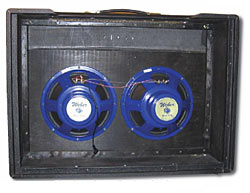
The cabinet after installing the Weber Blue Dogs.
Step 3: The Speakers
I narrowed my choice of Alnico speakers down to the Celestion G12 Alnico Blues and the Weber P12B Blue Dogs. The Celestions were rated at 15 watts while the Webers were rated at 30 watts — I decided to try the higher-wattage Weber P12B. After swapping out the reissue Greenbacks for the new Blue Dogs, I played the amp at lower volumes for several hours. At these levels (5-6), I was pleasantly introduced to the British chime of the 1960s. Early Beatles rhythm and lead guitar sounds were easily obtainable, particularly within the mid and bass ranges.
I then tried the full throttle test. At full volume, I was in for quite a shock — the mid and bass ranges nearly cut me off at the knees. The treble side was knife-edge harsh and the amp was monstrously louder. I was obviously disappointed, as none of this remotely sounded like a Bluesbreaker. I had read that Alnico speakers may require an extended “break-in” period, and I hoped that was the case here.
I removed the Blue Dogs from the Bluesbreaker cabinet and reinstalled them into a 2×12 cabinet I was using for weekend gigs. After a few weekends of extended playing, I noticed the sound changing, as I was having to re-adjust my amp head settings. After a few more weekends, I definitely noticed something happening. It was now time to re-install the Blue Dogs back into the Bluesbreaker cabinet.
Upon trying it again, something magical happened to the overall sound of the amplifier. Right there in my basement, and out of my rebuilt Bluesbreaker, came the sound. I was flabbergasted, as it sounded incredible. I must have played the amp all night. I was nailing all of Clapton’s Bluesbreaker riffs, and they sounded identical to recordings. The A minor solo break in “All Your Love” sounded amazing, and like the recording, it was drenched in sustain and overtones. “Stormy Monday” from Looking Back was spot on.
Finally, my Bluesbreaker renovation was complete. The amp sounded just like it should, some 40 years ago. Doing this yourself makes all the difference, as you become a part of the equation — with a little work and dedication, you can experience Marshall just as Clapton discovered it.
Source: https://mercurymagnetics.com/pages/news/PremierGuitar/PremierG-08.htm
3.4K & 6.6K & 8K primary — 8Ω tap
With lead wires — SuperStack (see FatStack) — Uses Grain-Oriented Iron
4K & 8K primaries — for use with two or four EL84s or 6V6s
4K & 8K primaries — for use with two or four EL84s or 6V6s
Leads with short stack
Leads (endbells available in most colors, including original vintage)
Large 60 watt — 3.4K, 6.6K & 8K primary — single 16Ω secondary tap
PT with Lug terminals like the original
Lower B+
JTM45 – Lower B+ — 350V – 0 – 350V B+ with dual 6.3VCT winds and a 5V filament winding.
As used on JTM45 — 350V – 0 – 350V B+ with dual 6.3VCT winds and a 5V filament winding.
Lower B+ — Universal Voltage Primary — dual 6.3V filament windings — no 5V rectifier winding — vertical mount ONLY!
2.1K & 3.3K primary — 8 & 16Ω taps
Single 16Ω secondary tap
FatStack with leads
20 watt with Leads
With lead wires — SuperStack — Uses Grain-Oriented Iron
3.4k, 6.6k & 8k primary — 16Ω tap
Leads
FatStack with leads
3.4K & 6.6K primary — 16Ω tap
All Mercury Magnetics® products are 100% handmade in California, USA.
Copyright © 1954-2018 by Mercury Magnetics. All Rights Reserved. Mercury Magnetics, Mercury Vintage, Partridge, FatStack, SuperStack, NewVolt, Mini-Choke, Multi-Choke, Mercury Custom Shop, Mercury Boutique, “The Heart & Soul of Your Amp,” “Holy Terror,” “Bad Guitar Tone — Whatever Its Evil Mission It Must Be Stopped!”, “Champ 600 Upgrade,” “XLG Upgrade Kit,” “Mean 13” and “The original British amp tone — shaken, but not stirred,” “Our Transformers are Stacked,” “The Essential Building Blocks of Your Tone,” “Mercury Studio-Pro Upgrade Kit for the VOX AC4tv,” UTM (Universal Transformer Mount), Amp-Saver and Copper-Tone are trademarks licensed to Mercury Magnetics. Axiom, ToneClone, Radiospares, VoodooScrew, Multiple Arrayed Geometric Inductive Coupling (M.A.G.I.C.), and APS (American Pro Series) are registered trademarks licensed to Mercury Magnetics. All other companies, products and trademarks mentioned on this website are trademarks of their respective owners. Unless otherwise noted Mercury Magnetics is not affiliated with any of these companies.
Mercury Mod and Upgrade projects and their documentation are the result of technical investigations made by the engineering staff of Mercury Magnetics. The disclosure of the information herein may pertain to proprietary rights, and the furnishing of these documents does not constitute an expressed or implied license to use such materials.
Mercury Magnetics® transformers and other products are in compliance with the European Union RoHS Directive 2020/95/EC with respect to the following substances: lead (Pb), mercury (Hg), cadmium (Cd), hexavalent chromium (CR (VI)), polybrominated biphenyls (PBB), and polybrominated diphenyl ethers (PBDE).
Mercury Magnetics® founded in Southern California in 1954 and incorporated in 1968.
CAUTION!
The voltages in your amplifier can be dangerous. Transformers and chokes are not user serviceable parts. Installation of these components should always be performed by an experienced technician.
The simple ability to use a soldering iron is not enough to qualify a “do it yourself person.” Those who are inexperienced in working with electronic circuits should never attempt to service their amplifier. Household line currents can be deadly!! Transformers, chokes and large filter capacitors can store a dangerous charge for several days or more after the amplifier has been unplugged. Never touch the terminals of such devices without being certain of their charge status. Risk of shock and damage to equipment may result from mishandling and/or improper use of these components. Please use common sense and always think safety first. After all, tone is most enjoyed when you are alive to hear it.

The newest family of transformer designs from Mercury. APS transformers are built and specifically optimized for today’s amps and today’s tubes. Due to power, modern tube production, design and chassis “real estate” limitations, not all modern amps can be modified or upgraded to handle the full-on affects of our Axiom, ToneClone, Radiospares or Partridge transformers. APS transformers correct many of the design limitations of the stock transformers to give you the most your amp can offer. APS transformers make your amp more reliable and better sounding. If you depend on your modern amps for a living, then you need the peace of mind APS transformers will give you. Transformers made to take the punishment of being on the road and keeping your amp running.
All APS transformers come with our Automatic Thermal Resettable Fuses. Ask your Mercury Sales Rep about this important new feature! All APS transformers come with both our 10-year Workmanship Warranty. APS transformers may be used for upgrades or replacements for modern tube-based guitar amp applications.
To find out more, or discuss to the characteristics of the different transformers sets available for your amps, give us a call or email.
Mercury brands marked with Plus+™ logo are cloned transformers with minor additions. You’ll only see the Plus+ logo on our ToneClone, Partridge and Radiospares catalog listings. They’re modified, without tampering with the original tone, to match today’s power company voltages and employ better noise immunity.
Variations include: added input power taps, added secondary taps, and other minor enhances to the originals. More good news — all Plus+ transformers come with both our 10-year Workmanship Warranty and Tonal Guarantee.
To find out more, or discuss to the characteristics of the different transformers sets available for your amps, give us a call or email.
Requests for educational consumer handouts about Mercury have been pouring in. So, we’ve designed this simple P.O.P. (point-of-purchase) display to make information on Mercury’s quality transformers available. The brochure discusses transformer upgrades and restorations, as well as our ToneClone, Axiom and Radiospares lines of vintage and next-generation products. A must-read for any guitar player!
Help your customers to learn more about the sonic-qualities of great transformer designs. Our eye-catching display is designed to hold 40 Mercury Magnetics “Unleash Your Amp’s Tone!” brochures.
Truly inspirational and superior tone has led you to the final link in the chain – Mercury Magnetics. Premium guitar amplifier power transformers, output transformers and chokes.
100% American made — no hidden imports — we really do make ’em from scratch, right here in California!
100% handmade and hand-tuned using only hand-wound components. We never compromise or play bean-counter games by short-cutting, attrition or using cheaper materials. Each and every transformer is consistent. If you ever need to replace one of our transformers, your amp won’t lose its tone — your replacement will sound exactly the same as the original.
American-made steel — we’re the only transformer manufacturer who custom orders, from an American steel mill, the unique alloys used in our transformers. These alloys are not only made here in the USA to military specifications, they are not available anywhere else in the world. They’re the same alloys used in the all-time best-sounding transformers during the “sweet spot” era (pre-1965) of guitar amplification history.
Things are never stagnant around here. Mercury maintains active and ongoing R&D (research & development). All kinds of new and exciting-sounding transformer designs (Axiom series), as well as our ongoing cloning of outstanding output transformers mined from the great old amps (ToneClone series). For vintage British amp freaks, check out our Radiospares, Hiwatt and Partridge series. And many modern amps can be upgraded with our APS series — our newest line of guitar amp-specific output transformers.
For any popular amp design we’re likely to have not just one but several transformers for different purposes and different tonal characteristics. It’s always a smart idea to discuss replacement, restoration or upgrading with your Mercury rep. — you’ll find his input invaluable.
Our output transformers are found in the amps of virtually every major player in the world. Many specify Mercury and won’t play an amp without them.
Mercury transformers are standard components or factory upgrades available in virtually all high-end boutique amps, including Fender’s boutique and custom shop lines.
Mercury transformers are so highly rated that they typically increase the value of any amplifier they’re installed in.

Your complete tonal satisfaction is our only goal. All Mercury Magnetics® APS®, Axiom®, ToneClone®, and Radiospares® products come with a Tonal Satisfaction Guarantee. If you are not satisfied with any Mercury Magnetics® transformer or choke, for any reason, you may return it within 30 days for an exchange or refund (minus all freight). See “Exchange or Refund Policies” below for addendums.

Mercury Magnetics® warrants its non-OEM transformers to be free from defects in material and workmanship, if properly installed, under normal use for a period of TEN (10) YEARS from the date of purchase, and by the original owner. Note: this warranty does not cover damage caused by external sources or user error. Defective transformers will be replaced or repaired at our discretion. To the extent permitted by law, the foregoing is exclusive and in lieu of all other warranties or representations whether expressed or implied, including any implied warranty of merchantability or fitness. In no event shall Mercury Magnetics® be liable for special or consequential damages. All warranty returns are examined by our engineering staff to determine the exact cause of failure. This warranty is void if your transformer has been tampered with. See “Exchange or Refund Policies” below for addendums.
Your quest for truly inspirational and superior tone has led you to the final link in the chain – Mercury Magnetics. Premium guitar amplifier power transformers, output transformers and chokes.
Transformer sets are often misunderstood, yet vital musical components. They’re integral to the nuances of your guitar amp’s sound. Far more than tubes, speakers or other amp components, the transformers establish the platform for shaping your amp’s unique sound.
Today’s players are more informed and demanding than ever. They hear the differences and know that both transformer design and build-quality have a dramatic effect on their tone. Indeed, if your tube-based amp is suffering from bland and unexciting tone then it’s probably related to low-end or poorly designed transformers. As amp designers, techs and manufacturers have discovered, the practice of dumping generic, low-bidder transformers into their amps doesn’t cut it any more. And now you know why.
Within the player community no other company commands as much respect as Mercury Magnetics. You can depend on our uncompromising, fanatical build quality, consistency and reliability.
All of our transformers are 100% handmade by us here in California, USA. They come with an unheard of 10-Year Workmanship Warranty as well as a money-back Tonal Satisfaction Guarantee.

Did you know that tube-based guitar amp transformers are unusual and very different from industrial as well as audio transformers? And did you also know that it is impossible to engineer the “perfect” guitar amplifier transformer from strictly “by the book” specifications? Interestingly, almost all of the great-sounding amp transformers contain either flaws, “happy accidents,” or have other issues in their construction that were not part of their original specifications.
Decades ago, when Mercury’s engineers first discovered these curious phenomena, the music industry was already in the process of losing its references to tone. In the throws of converting to solid state, tube and transformer platforms were mistakenly being relegated to relics of the past. Those who knew the original technology were either retiring, dying off, or jumping ship for the “new improved” way of doing things. By the time we collectively began to realize what was happening to guitar tone, it was almost too late. “Old school” manufacturing had been all but shut down and as quality dwindled N.O.S. (new old stock) components became the last bastion of our tone.
It was during those Dark Ages that the transformer connection to tone was almost lost completely. However, Mercury was there as a hold out — and even when it wasn’t fashionable, never compromised. But as often happens, when an older era fades, the remnants of what made it great were readily available to study. And like archeologists, Mercury’s engineers began sifting through the bones of the most coveted old amps in an attempt to discover what made them better, and often times so different than others.
The resulting products of those studies were the earliest ToneClone and Axiom designs. Mercury quite literally evolved a new science of guitar amp transformer design for tube-based guitar amps from there, and has continued to innovate and revolutionize it since. Perhaps few people realize the significance of these discoveries and the resultant developments. But without Mercury’s catalog of transformer designs, guitar tone as we knew it would have been lost.

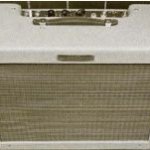
After a hiatus of 45 years or so, Fender has been carefully re-entering the business of building hand-wired tweed amplifiers with the resurrection of the narrow panel ’57 tweed Twin and the ’57 Deluxe. Of course, there are scores of small amps that have been inspired by the Deluxe, and many more 5E3 knock-offs being built today in the “subbooteek” cottage industry comprised of solo solderers who build in their spare time and often put their work up on eBay. For some cost-conscious players, a tweed Deluxe for $600–$800 is a deal that cannot be refused—even if the amp was wired up by an unknown tonehead on a basement workbench in Akron. But Fender is Fender, and while they chose to ignore the thriving boutique market for hand-wired tweed circuits that blossomed in the early ’90s with the appearance of Victoria, they have not forgotten how to put an amp together, and in the case of the Deluxe sent to us for review, it stands apart from all the rest with a very unique voice.
We asked Fender’s Shane Nicholas and Sergio Hamernik at Mercury Magnetics to explain the process of natural selection that evolved during the development of the ’57Deluxe….
TQR: Describe the process in which your design team evaluated various vantage examples of the 5E3 Deluxe, and how widely the actual sound of the vintage amps you listened to varied, specifically?
Shane:There are several guys here at Fender who own old amps, and we also have friends who do. When we were ready to begin the’57 Deluxe project, we brought in a few original vintage examples, and a couple of “boutique” versions of this type of amp. We listened to all of them with various guitars, and listened to each amp chassis hooked up to the others’ cabinets. Keep in mind that every amp—especially 50-year-oldones, will sound a little different than another one of the same model. It’s pretty well documented that Leo Fenders some times changed components “on the fly,” while the official schematic documentation would be updated later. My old Deluxe might have been built with some different stuff than yours, even though they were both “stock” 1957 5E3models. Then add in aging, abuse, repairs, etc., and it’s a wide target that needs to be narrowed. For example, we had one amp here that was much more distorted sounding than the others, so unless you are only laying 1951 Howlin’ Wolfstuff, you probably wouldn’t like that amp as much. For me, the ideal is an amp that gives a beautiful clean tone with the volume set low, and a dirty, harmonically rich tone with the volume set high. You should also be able to set it on, say, “5” and control the amp’s distortion by simply varying your pick attack. We decided that one of the old ’57s was the most desirable example of a 5E3 Deluxe, and we used it as the golden sample.
Once we got to this point, project engineer Nick D’Amato really got down to business. The final schematic and components we chose were basically picked so the prototype would sound as close as possible to our golden sample amp. Obviously, we use new parts, not 50 year old stuff from a flea market or whatever. We also had to make a few changes in order to pass modern worldwide safety regulations; things like shielding, ground wires, and the three-prong power cord, which negated the use of the old ground polarity switch. We put a Standby switch in its place, which is a good thing. These changes don’t really affect tone, but they do reduce hum and improve playability.
We also decided to go with 12AX7s in the preamp, even though the originals were designed with the 12AY7 in the front end. Our thinking was, not only is the 12AY7going to be tough for us to get in quantity, but many players in fact prefer the 12AX7s higher gain. If you are playing ZZ Top stuff, for example, you’ll probably prefer this. The12AY7 will work, however, so some owners will buy one and stick it in their amp.
The transformers are also a crucial piece of the puzzle. We auditioned quite a few prototypes, and some of them were too efficient or too distorted, etc. One of the vendors we contacted was Mercury Magnetics, whom we’ve worked with in the past They sent us five different power and output samples, each based off an original transformer set found in a vintage Deluxe amp. During A-B tests, one of these closely matched the OT in our golden sample amp. We worked with Mercury to make a few tweaks, and soon we were positive we had the right transformers.
TQR: How many different types of speakers did you consider?
Shane: Well, the original Jensen in my old Deluxe really sounds and looks perfect, like you’d expect. We found that the new Jensen P-12Q sounded close enough, so we stopped looking. In my ten years at Fender, I have discovered that no matter what speaker we supply in a tube amp, a certain percentage of customers are going to try something else. Celestion, Jensen,Eminence, and boutique guys like Weber all have their supporters and detractors. It’s human nature to tinker with your machinery, and a speaker swap is one of the easiest mods you can do to an amp.
Now, having said all that here’s where it gets fun. One of the boutique amps we tried happened to have a Celestion Blue Alnico speaker in it, and it sounded very good. So we tried that speaker with our prototype 5E3 amp, and said,“OH MY WORD!” I had heard that speaker before in different amps, but this combination was stunning. The amp became a lot louder, for one thing.We thought for a minute about using this speaker in the ’57 Tweed reissue, but it’s not really the authentic, original sound or look. It’s also a lot more expensive. So, we remained sold on the Jensen, but when we developed our limited edition, black lacquered version—the Fender 57 Amp—we decided to equip it with the Celestion Blue.
TQR: What are the unique challenges involved in building hand-wired amps, compared to those with a printed circuit board?
Shane:Making it look and perform like the old amp while using readily available parts that we can buy in quantity. I am a stickler for performance, but if our customers didn’t care to look inside, we wouldn’t worry about the looks of the components and wire so much. For example, Alexander Dumble told me he likes our new ’57 Deluxe, and was surprised that we used such heavy wire in the chassis, as it’s really not necessary. We can’t pass modern safety regulations using cloth wire, so we got the next best thing. I’d also like to mention that, while we build higher quantities of hand-wired amps than all the other boutique builders, it’s still a very small number compared with the number of PCB amps we build, like our Hot Rod series and all the sold-state models. Our factory estimates about eight times the labor in a Vibro-King versus a ’65 reissue amp with a PCB.
TQR:We would assume that Fender has a separate group of employees devoted to building the hand-wired amps.
Shane: We do have the hand-wired team in a separate area in the factory. They are highly trained, patient employees who take a lot of care with these amps. Most of them are women, same as Leo’s day, maybe because they tend to be more patient than us dudes. And women’s hands tend to be smaller, making it easier for them to run wires and solder connections in the tight confines of the amp chassis. I don’t know the training regimen off hand, but I believe many of them cut their teeth on guitar wiring before moving on to amplifiers.
TQR: With the tweed Deluxe in production, are there plans to develop additional hand-wired Fender models of the past?
Shane:Yes. The list of great old Fender amps begging for reissue is a long one!
In case you don’t know, Mercury is known for having acquired and cloned hundreds of stellar vintage transformer sets that com-prise their ToneClone and Radiospares series…
TQR: How did you become involved with the development of the 5E3 specifically?
Sergio: It call came about as a follow up to the ’57Twin-Amp reissue project that we were a part of a few years ago. Mercury designed and supplied Fender with the transformers for those amplifiers, which was a very successful endeavor—so much so that Eric Clapton made them his main amps for his own tours and the Cream reunion tour.The momentum started by the ’57 Twin-Amp project quickly created a demand for some sort of follow-up amp in this positive vibe, and Fender’s decision to reissue the 5E3tweed Deluxe came as good news to us. It is probably the most copied circuit on the planet, and I couldn’t think of abetter project to sink our tranny designer teeth into.
Years ago the late Ken Fischer, of Trainwreck, told me that the Deluxe was an early inspiration for him to get into amp building. He went as far as to refer to the Deluxe circuit as the cornerstone of the boutique market. It’s a truly different dynamic when the company that started it all wants to reintroduce a benchmark in amplified guitar tone, and especially when their goal is to make the amp sound as fresh as it did when it was first launched. We’ve worked for decades acquiring our extensive library of transformer designs that originate from variants of pre-production to pilot runs of many vintage amps, so amplifier companies often consult with us because we’re a small but dedicated group just nutty enough to be the conservators of such things.
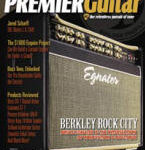
A few years ago the guitar playing community experienced a resurgence of low-wattage amps. I’m not sure if it was because of the weight or the sheer volume larger stacks delivered, but the search was renewed for amps that could provide the same tone at an easily manageable weight and sound levels that didn’t make bartenders/engineers/wives scream, “Could you turn that down?”
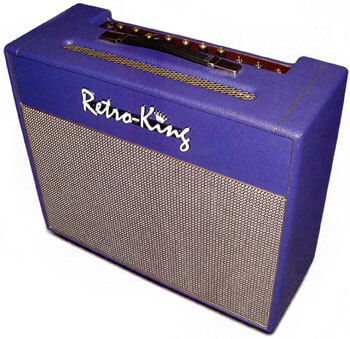 This brought renewed interest in an obscure Marshall amp, the model 1974, an unassuming 18-watt combo. Originally available as a 1×12 — and closely related to the 18-watt model 1958 (2×10) and model 1973 (2×12) combos — the amp featured two EL84 power tubes, three ECC83 preamp tubes and a 6CA4 (EZ81) rectifier tube. There was even a rare reverb-equipped model, but all of the amps featured both a normal channel and a tremolo channel. The magic of the model 1974 was that with just a Les Paul and a cable players could approximate the beloved Eric Clapton “Beano” tone used on the Bluesbreakers with Eric Clapton album. Although I should note that Eric actually relied on a JTM45 combo, interest in the Beano tone ensured the 1974’s place in guitar lore. As was to be expected, clones of this amp began popping up rapidly once the originals, now extremely rare, began fetching prohibitively high prices.
This brought renewed interest in an obscure Marshall amp, the model 1974, an unassuming 18-watt combo. Originally available as a 1×12 — and closely related to the 18-watt model 1958 (2×10) and model 1973 (2×12) combos — the amp featured two EL84 power tubes, three ECC83 preamp tubes and a 6CA4 (EZ81) rectifier tube. There was even a rare reverb-equipped model, but all of the amps featured both a normal channel and a tremolo channel. The magic of the model 1974 was that with just a Les Paul and a cable players could approximate the beloved Eric Clapton “Beano” tone used on the Bluesbreakers with Eric Clapton album. Although I should note that Eric actually relied on a JTM45 combo, interest in the Beano tone ensured the 1974’s place in guitar lore. As was to be expected, clones of this amp began popping up rapidly once the originals, now extremely rare, began fetching prohibitively high prices.
I was fortunate enough to have quite a bit of exposure to these early Marshall amps, having worked with a shop that had no less than six of the model 1974s in stock during my tenure. One exceptional example was retained for studio use. A number of renowned guitarists had used the amp over the years, and they all agreed that it was one of the best — if not the best — they had heard.
A few months ago I was invited to Houston, Texas, by guitar legend Billy Gibbons, to bring a 2×12 Marshall model 1973 to the studio for a new ZZ Top album. Billy is an avid fan of 18-watt amps and has numerous clones to choose from, in addition to two original 18-watt Marshall combos. While we were listening and comparing sounds, I noticed a green Tolex 2×12 combo called the Retro-King 18 Watt sitting in the studio. Once he plugged into it, I knew both the original of the tone and that I had to check one out for myself.
King for a Day
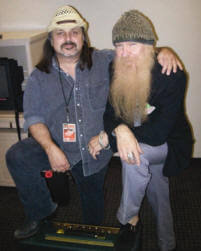 The Retro-King 18 Watt is a completely custom-built amplifier, with the features you would expect to see in an amp of this class, including a solidly built, Baltic birch cabinet and handwired point-to-point construction. The fit and finish on everything from the cabinet to the Tolex covering was impeccable. The model I tested for this review had a 12″ Mojo Tone British Vintage Series speaker, although builder Chuck Dean will install others by request. The entire enclosure is substantial and provides for a big box tone from a single speaker combo. An impedance selector is included which is great for those planning to use this amp with other speakers or additional cabinets. The transformers are custom-wound to original Radiospares specs (an optional Mercury Magnetics transformer is available by request).
The Retro-King 18 Watt is a completely custom-built amplifier, with the features you would expect to see in an amp of this class, including a solidly built, Baltic birch cabinet and handwired point-to-point construction. The fit and finish on everything from the cabinet to the Tolex covering was impeccable. The model I tested for this review had a 12″ Mojo Tone British Vintage Series speaker, although builder Chuck Dean will install others by request. The entire enclosure is substantial and provides for a big box tone from a single speaker combo. An impedance selector is included which is great for those planning to use this amp with other speakers or additional cabinets. The transformers are custom-wound to original Radiospares specs (an optional Mercury Magnetics transformer is available by request).
The 18 Watt has a couple of different features that I found to elevate this amp above some of the other 18-watt clones currently available. First, is the Master Volume control. You may ask why a Master Volume is needed for a low-wattage amp; while it does function to reduce the volume when the amp is cranked (bringing us back to that whole bartender/engineer/wives problem), it more importantly regulates how hard the power section is hit by the preamps. How the power section is driven affects everything, including the tone, overdrive and response of the amp, making the Master Volume a critical part of the circuit. The 18 Watt’s Master Volume circuit does not feel or respond like other Master Volume circuits I’ve heard; this one allowed me to get a wide variety of classic 18-watt tones, as well as the sounds of other model 1974 clones on the market. The Retro-King also features a tube biased tremolo like the original — it sounds wonderfully authentic, deep and a little Voxy. A footswitch proved to not only turn the tremolo on and off but to select between two speeds.
The second unique feature packed into Retro-King’s 18 Watt combo is a switch that allows for the selection of a tube rectifier or solid-state diode. The diode setting, while obviously not an original Marshall feature, provided more definition and headroom than the tube rectifier. When tube rectified, this amp has that sweet sag and compression that blues players love. If a player buys this low-wattage combo but is more accustomed to larger amps, this innovative feature will make it fee4l a bit more familiar — definitely a nice touch.
Of course, not all potential users of small amps are blues players. As a matter of fact, when I hooked the amp up to a Marshall Guv’nor pedal and set it for a very clean, high-headroom sound I was rewarded with a great rock sound. The tone was similar to Gary Moore, or even a bit more intense than that, if needed. The amp’s overdrive without a pedal ran from Black Crowes territory to the always-wanted, rarely granted “Beano” tone. Also surprising was that a Strat sounded excellent through this amp — something that I haven’t consistently found in other clones. The harmonics are rich, a la Billy Gibbons, especially when using pick harmonics. The 18 Watt cleaned up nicely and captured my picking dynamics perfectly.
The Final Mojo
I found the Retro-King 18 Watt 1×12 to be louder than the real thing, but with an authentic rendering of the actual tone for which these amps are famous was always there. I was also able to get higher-headroom, punchier tones that I was not able to get with the original. The original produced a slightly more compressed tone when driven hard with humbuckers but this would not have been obvious if the original had not been sitting right beside the Retro-King. In fact, the tones were so similar that I would have been guessing which one was which in a blind taste test. All in all, the Retro-King is more versatile than most other 1974 clones, without sacrificing the reason one buys an 18-watt Marshall-type amp in the first place.
Source: https://mercurymagnetics.com/pages/news/PremierGuitar/PremierG-12.htm
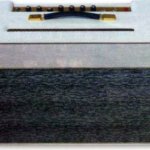
Because there are so many kits and builders in today’s DIY and boutique amp market, you no longer needed to be a super shredder or fretboard wizard to have a “signature” amp. Nope. Today, the only thing between you and the amp of your dreams is a little bit of cash.
For roughly the price of a boutique amp, you can build and customize your own rig – Tolex, grill colors and materials, cabinet plastics and wood types, tube combinations, speaker pairing and sizes, power output – virtually any idea you can think up, and chances are someone can make it a reality. I recently build a 2×12″ 18-watter to my own specifications. Here’s how I did it.
I hemmed and hawed between something more modern-looking and a traditional Tolex-covered cabinet. There are great cab builders who use all kinds of wood. Some variations of the classic tone woods (pine and Baltic birch) are wonderful – walnut, wedge, maple, mahogany, basswood all produce different qualities, and craftsmen are using combinations of them to produce interesting tones. But because I was making my own version of a classic, I decided to go with a traditional cabinet.
The one custom mod I asked Peter to include was to build the cabinet of pine; I’ve always loved the resonance and timbre of pine cabs, and it’s a bit lighter than the birch used in Marshall cabs.
Peter convinced me that while pine would work, I should stay with a birch baffle to retain some of the characteristic bite conveyed by the wood used to build the amp we’re copying.
To further the customization, and give the amp a touch of fun, I decided on white Tolex. Per my request, Peter aged the cab to give it a broken-in appearance.
While I wanted this amp to sound like a Marshall 18-watt, I also wanted more control over its tone. I wasn’t interested in tremolo or reverb as much as saturated overdrive and the ability to obtain overdrive at less than ear-bleed levels. I opted for a Ceriatone DIY kit, which they assembled for a small fee. And since I already had a drawer full of old mustard caps and NOS resistors, I figured I could upgrade some components down the road, if necessary.
Ceriatone had a two-channel Treble/Middle/Bass (T.M.B.) circuit with a Master Volume on the second channel that fit the specifics I was after. I was happy with the quality of workmanship – it had solid solder joints, all around.
I firmly believe transformer iron makes a big difference on an amp’s overall tone and character.
For an 18-watt amp based on a Marshall, you have a power transformer and an output transformer. In the 1940s and ’50s, some power transformers could handle up to eight times the output of an amp! The more muscle, the better the tone.
While an adequate power transformer insures an amp will run at optimum output and efficiency, the output transformer is what really counts when it comes to delivering tight lows and harmonics, and musical sound quality at different volumes.
There are companies making custom transformers and reissuing certain classics, and they all have distinct sounds and characteristics; some are brighter, some more harmonic, some offer crisper note separation, etc. Choosing one is, of course, a matter of taste. Since I was going for that classic dark vintage Marshall sound, I went with Mercury Magnetics, which offers a few choices when it comes to Marshall-style 18-watt output transformers, all based on classic Radiospares transformers from the ’60s and ’70s (which is what Marshall used in the 18-watters). I opted for the handwired ToneClone.
I played with various speakers – Jensen, Celestion Alnicos, old CTS speakers from a Hammond organ, and a few more mismatched combinations. But the thing that really worked was a pair of mid-’60s 20-watt Celestion greenbacks. To my ears, there’s something about an aged magnet in a speaker that makes it less harsh. The 20-watters captured that sweet spot. They’re articulate, punchy, and I really like that they don’t have the boomy low-end of their 25- and 30-watt counterparts. Aside from that, I had an old set that were signed by Alexander Dumble! Not that it makes a difference, tonally, but it’s cool!
Now, some guys wouldn’t pay that much mind to grillecloth, beyond its color. But there are dozens of variations out there… but none of them capture the look – and more importantly, the “feel” – of the vintage “Bluesbreaker” amps.
In the ’60s, Marshall used a rubbery grillecloth material that has never been accurately reproduced. It muffles and colors the amp’s sound in a way that’s unmistakable to old Marshall amps. While I wasn’t opposed to using some funky grillecloth, I really wanted to capture that classic sound. Luckily, I stumbled upon E.C. Collins, who hand-makes a near-duplicate cloth.
While there are plenty of manufacturers making quality tubes these days, I had all the vintage tubes I needed lying around from old projects. The only one I had to source was the rectifier tube, an NOS Mullard EZ81. I had two Valvo EL84s, which I used for the power tubes, and a vintage Mullard, and two vintage Amperex Bugle Boys, which I used for the three ECC83 preamp tubes.
There’s no reason to sacrifice quality to hit a price point. Sure, you might have saved a few bucks if you buy a mass-produced amp, but if you’re after tone and personality, with a little bit of time and planning, you can build the amp of your dreams.
My amp turned out better than I could’ve hoped, and since every component was sourced to my own specs, it truly speaks to me! VG
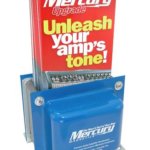
Requests for educational consumer handouts about Mercury have been pouring in. So, we’ve designed this simple P.O.P. (point-of-purchase) display to make information on Mercury’s quality transformers available. The brochure discusses transformer upgrades and restorations, as well as our ToneClone, Axiom and Radiospares lines of vintage and next-generation products. A must-read for any guitar player!
Help your customers to learn more about the sonic-qualities of great transformer designs. Our eye-catching display is designed to hold 40 Mercury Magnetics “Unleash Your Amp’s Tone!” brochures.
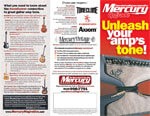
BROCHURE PAGE 1
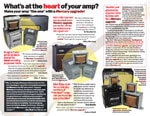
BROCHURE PAGE 2
It’s available for dealers and resellers — free! Getting a display for your store is easy — just give Patrick a call (or email) and ask for one!
Source: https://mercurymagnetics.com/pages/SSN/pages/POP1.htm

With permission, Mercury’s logos and artwork may be used on websites, printed advertising, business cards, affixed to MI products that contain Mercury’s transformers or chokes, and other product as well as promotional material. For permission or other special uses, please contact Mercury’s sales department sales@mercurymagnetics.com for details.
![]()
Mercury Magnetics
![]()
“The Heart & Soul of Your Amp”
![]()
ToneClone
![]()
Axiom

Radiospares

Mercury Custom Shop
![]()
Mercury Vintage

“Beauty” shot #1

“Beauty” shot #2

“Beauty” shot #3

“Beauty” shot #4

“Beauty” shot #5
Source: https://mercurymagnetics.com/pages/SSN/pages/MercArt.htm

the way your nasty little amp makes you play…
So where does great tone come from if nearly everybody is using the same parts from a small circle of high production manufacturers? What gave vintage amps their great tone and why do some amps sound better than others? How come so many new amps don’t have that inspiring tone anymore? And where do babies come from?
The answer to (most of) these questions, and the absolutely mission of Mercury, is in the TRANSFORMERS. We’re not kidding when we call them the “heart and soul of your amp.” Transformers establish the character and behavior of your amp’s ability to generate tone, from clean, to dirty harmonic distortion. That’s why Mercury goes through the trouble and expense to build and tune transformers the hard way: by hand, one-at-a-time, with old-world craftsmanship and the most tonally effective materials money can buy. The end result is all the guitar tone you want without a speck of cereal.
But what does the future hold for the electric guitar player and vacuum tube guitar amp owner? Is there truly something out there beyond the limits of vintage tone that isn’t going to be solid-state? Yes, we think so. With just the right combination of know-how and passion, Mercury is now helping amp builders re-think guitar tone by re-inventing it. We call these new tone-generating machines Axioms. The Axiom line showcases new advancements in magnetics through transformer design. Designs that give amp builders better tools to work with and tone that we feel will better connect you to your guitar. All without following conventional vintage designs or recipes.
One fine example of Axiom-based advanced transformer technology is Mercury’s Epiphone Valve Jr. Kit*. What started out as a simple demonstration of Axiom transformers gave a $100 economy tube amp $1,000+ worth of tonal performance! It’s hard to believe there isn’t a vintage bone in their windings! We’re not surprised that this best-selling kit is fast becoming the first choice of pro players and recording studios alike.
Imagine an affordable entry into the world of boutique amps that delivers top-shelf vintage American clean tones all the way to the overdriven distortion of the old British amps. Also imagine an amp that totally responds to every tone knob and pickup adjustment setting on your guitar. It’s fun stuff!
Our little upgrade kit is a showcase of what the future has in store for harmonically-rich tone. We invite you to check out our Epiphone Valve Jr. Kit and hear for yourself just what everybody’s talking about. Or ask your amp tech about other Axiom upgrades for your amps. Remember, in addition to our already amazing-soundingToneClone and Radiospares lines we make Axioms for most popular amps.
Source: https://mercurymagnetics.com/pages/_misc/FAQ.htm#Give_me_your_dirty_tone
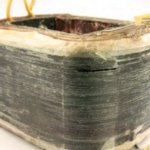
Last month, Sergio Hamernik, head honcho at Mercury Magnetics, walked us through the intricate process of rewinding a vintage transformer. This month, we dig a little further into the details of winding, materials, the ways age affects some transformers, and why some of them fail.
When you rewind a transformer, do you use the same wire used in the 1950s and ’60s?
No. We use high-purity, oxygen-free copper magnet wire made in the U.S.A., and we use it because of its tonal properties – it’s sonically superior and more consistent than the wire used in the ’50 and ’60s. Wire, back then, had about half the temperature and electrical performance capability of Mercury’s standards.
We, as players, would prefer to use wire from the ’50s and ’60s compared to offshore and south-of-the-border wire. We tried them, thinking we’d save our customers some dough, but test results yielded dull tone and we saw inconsistent batches with too many instances of insulation breakdown. The stuff was not even up to the standards of vintage wire. Further, in real-life tests putting amps through their paces, the sonic differences were noticable to the guitar players here at Mercury, and those working for the recording studios here in Southern California.
Have you ever seen a negative effect of age on a transformer?
In some cases, yes. Sometimes, your ears pick up on the effects of aging before you realize what’s happening – they produce dark, dull, and fuzzy tones with a general sense of lower output volume.
If anything in a transformer suffers from aging, it will most likely be the core. Two major contributors cause a negative effect of aging and affect your tone. Before World War II, the science of processing iron was not up to snuff. It was difficult to boil out residual carbon, and even a miniscule amount of carbon in older iron causes it to age. As an iron core ages, its magnetic conductivity begins to poop out, slowing the transformer’s responsiveness with increasing losses. The result is less output with only lower mids breaking through.
During WWII, the war effort created a shortage of iron. So, many transformer companies made cores from sheet metal, like that used to make soup cans! These had the wrong kind of iron and harbored plenty of carbon, to boot – do not confuse iron with steel! Finally, when silicon was implemented to help force the carbon out of post-war iron, transformer iron became stable enough to outlast us all.
Another contributor to transformer aging comes from humidity. Amp owners who live in humid climates have noticed their tone changes over the years, especially if their older amps had transformers built around paper bobbins, which have always run the risk of moisture absorption affecting tone. Conversely, we found that transformers with plastic bobbins weren’t likely to suffer tone degradation via moisture saturation. A couple excellent examples are the original Partridge and Radiospares transformers from England – with the fog and rain they experience, these transformers held up quite well. That may explain why coating paper in wax was attempted early on, and to verify that humidity affected output transformer tone, we flew in transformers from amps made in the ’60s that had never left the U.K., all with paper bobbins, and put through a dehumidifying process, then re-sealed them in varnish and gave them a full bake. The owners freaked out and thanked us for giving them their original tone back! One called to thank us personally when he realized it was his tone fading over the years, and not his ears! He said that as time passed, he noticed less treble and a lot less note separation and definition. Others had this mastaken belief that their amps were getting too old to play.
Obviously, the rewound transformer for the 1960 Vox AC15 we’ve been working on the last few installments won’t be dipped in wax. What will you use to insulate it?
It’ll receive a fresh dip of varnish.
What can we expect the differences to be between the rewound transformer and the original?
It should sound as good as when it left the showroom in 1960. The only other option, as far as upgrading the tone, would be to try one of our ToneClones, which are copies of the finest celebrity-owned and played “pick of the litter” transformers. It’s likely you’ve heard these transformers in action on your favorite recordings.
Has a rewound transformer come back to you shortly after it was sent out?
Yes. Installer error happens, and if you don’t find and fix the problem that caused the transformer to blow in the first place, you’re setting yourself up for a repeat performance.
Another thing that’s fairly common is the use of N.O.S. tubes, usually bought from an online auction. We had a customer who, after installing his rebuilt output transformer, decided to re-tube his amp with 40-year-old American-made originals. As luck would have it, one of the tubes shorted and caused a different failure in the newly rebuilt transformer.
Is every old transformer destined for a rewind, or could some go on forever?
Not every old transformer will need to be rewound, if taken care of poperly. Most may outlast the “Iron Age” of guitar transformers, which we’re living in now. The push for solidstate technology is tenacious enough to replace tube-/transformer-based amps in the long term. Tubes may go, but they’ll have to pry the transformers from my cold dead fingers before I’ll give them up!
We recently put transformers of all kinds – old and new – to the test by volunteering to help flood victims in Nashville. We offered to test and restore water-damaged transformers, and encountered some pretty nasty stuff. Yet, less than five percent of them needed to be rewound – namely, those with paper bobbin insulation or amps that had been turned on before the transformers were tested. Some transformers were from amps that had been submerged in sewage for weeks! The odor was so foul we had to air them out, and the staff actually had to draw straws to determine who was going to work on them.
You must have your share of unpleasant jobs….
Man, you got that right! But there’s nothing like the fresh smell of varnish in the morning to help one deal with that challenge. We did manage to extract the moisture and re-seal these transformers with varnish. The sacrifices you have to do to help fellow musicians….
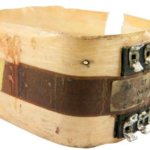
Last month, we dropped off a toasted output transformer from a 1950 Vox AC15 with Sergio Hamernik and the team at Mercury Magnetics. From a suspicious pin-sized burn in the transformer’s outer paper insulation, they were able to determin probable causes for the transformers untimely demise. Then it was onto the rewind process! So, is it over for this amp’s output transformer?
VG: What goes into the process of rewinding a transformer?
We begin the restoration process with a thorough testing of the transformer’s electrical performance. Then we put the transformer’s insulation system through its paces – checking its integrity, making sure the voltages inside the transformer stay where they belong and not going wonky by arcing over to neighboring windings.
Consider these steps a weeding out process to find the proper candidates for restoration. If the transformer in question passes, then we return the transformer back to its owner or tech. Believe it or not, about 1-in-4 transformers we receive pass our testing! We offer free-of-charge transformer testing to anyone – all they have to do is cover the shipping costs. Some of these transformers are sent to us simply to make sure that all is operating well within specs – essentially for a second opinion.
We consider it a “sin,” a violation of our sense of professional ethics, to tamper with a perfectly good transformer. Rewinding or restoring transformers is a service born out of our passion for preserving tone at its highest standards. Properly rewinding transformers is a time-consuming and costly endeavor. The reality is that our rewinding service is not exactly a profit center. Who knows, maybe one day we’ll sober up and quit doing it altogether. But it does break our hearts when we find vintage transformers ruined by feeble attempts at rewinding by people who do not posses the necessary skills, or who do not have an interest in or knowledge of guitar tone.
If the transformer does fail our testing in any way, then we deem it unsafe to be put back in its amp. Now the process of rewinding begins. A large part of this process is akin to archaeology, or perhaps autopsy. We want to find out precisely how it was made and discover who or what killed it. So the first thing we do is remove the core stack and catalog each plate for original position and sequence. Check out the photo of your core completely apart and tagged. We did find some rust and will do our best to preserve it.
it. So the first thing we do is remove the core stack and catalog each plate for original position and sequence. Check out the photo of your core completely apart and tagged. We did find some rust and will do our best to preserve it.
We actually talked about that in an article we did back in the August 2009 issue of VG.
Yes that’s right. That patina of rust on the core of your transformer is an indicator of better quality iron that is ideally suited for guitar tone. The rust itself is working in league with the iron to assure that level of tonal performance. Modern day technology messes with the original iron processing recipes by adding rust inhibitors and other fillers. They’ve short-cut the more time-consuming and costly metallurgical processes – just like how auto makers are putting in more plastic than metal in their cars. Iron is an amazing magnetic conductor until it gets diluted or polluted with things that are better suited for non-audio applications. So if I had my choice, I’d prefer to play an amp with rusty transformers delivering the tone I want rather than an amp with pristine rust-free transformers that make the amp sound like it’s got a sock stuffed down its throat.
So the original core will go back in the transformer?
Yes. Since you have the right kind of iron core we’ll reassemble it the way we found it, then retune it to the original factory specs. If you were stuck with a transformer that had inferior core material, then we would suggest swapping it with Mercury upgrade iron.
It’s come to our attention that many current production transformers marked with “Made in the U.S.A.,” are actually using offshore materials, i.e. magnet wire and steel. More accurately they should read “Assembled in the U.S.A.” These self-defeating transformers are good candidates for our upgrades rather than rewinds.
Cores are the first component out and the last in during the course of restoration. An interesting fact: cores are never at fault when it comes to a transformer breakdown. The core is removed solely for us to gain access to the coil of the transformer. Taking apart the coil is a surgical process that begins our forensic investigation – like the crime shows on TV. Unpeeling a coil is quite revealing and will tell us the story of what happened. Under interrogation the coil always tell us the truth. A body of a man is wheeled in to the morgue. His wife insists that he shot himself while cleaning his gun – but the autopsy’s evidence proves otherwise. Now she’s under suspicion.
Well the coil of your transformer quickly spilled the beans. Remember that small black spot we noticed on the outer wrap of the coil? Sometimes there are innocuous blemishes in the form of spots that may appear on the surface of paper and are nothing to worry about. However, what we normally find in fried transformers is that the burn begins somewhere in the middle of the coil and works its way out – causing an exit wound. In your case the failure was not typical. Yours was an entry wound.
This is important because it indicated to us that it was killed by a sharp instrument that penetrated the outer insulation that broke through and severed two turns of the fine wire that make up ½ of your primary winding. Meaning that only one of the two power tubes was operational. The damage to the entire transformer was limited to that spot and only the very top layer of the magnet wire. Those broken wires were arcing across each other and taking advantage of the oxygen available from the perforation of the outer wrap to form that black spot. Further evidence to support these findings is the fact that the rest of the winding, all the way down to the bobbin, was unharmed.
This type of injury is caused by the usual suspects – the installer or remover of the transformer. The smoking gun possibilities are: the tip of a soldering iron, the tip of a Phillips screw driver… or rough handling (dropping or bumping the transformer against something sharp, etc.) with enough force to puncture it to cause such a failure. And finally, we cannot rule out beer as another possibility.
You can now relax. Your tubes and speaker are now ruled out as possible components of interest.
What gets burned out in a transformer that you’re actually replacing?
The magnet wire. When its insulation gets over taxed the fuster-cluck begins as the insulation system of the overall coil progressively losses its integrity (dielectric strength) and begins to arc or burn.
Can you ever rewind a transformer with its original wire?
We certainly wouldn’t do it. When the tires of your car are worn out, do you go out and buy used ones to replace them? Unless you’re a former stockbroker, what’s the point?
Magnet wire is not bare copper wire. There is a micro thin coating of plastic insulation that protects it from shorting. That very thin layer of plastic is susceptible to microscopic spider web-like cracking. And the process of unwinding the magnet wire virtually assures it’s going to get damaged.
Check out the photo of what the magnet wire from your transformer looks like after it was unwound. Does this look like something you’d want to put back in your transformer?
Has any of the machinery used for rewinding changed over the years?
Most of our methods and equipment for rewinding transformers we consider proprietary. So I’m going to stay away from specifics. However, the basic concept of winding equipment hasn’t really changed for over the last 100 years. Today, of course, we see more computerized machines. But we chose to stick with the gold standard of vintage equipment
Aside from ours, I’d be surprised if there is any precision equipment available that is dedicated for the sole purpose of unwinding/rewinding. Most attempts at rewinds today just use run-of-the-mill winding machines that produce, at best, haphazard results.
So if someone gives you a prized “mojo” tranny, do you have the capability of rewinding it exactly the way it was before?
You know I’m not a big believer in mojo. I maintain that all things to do with amps and their respective tone can be easily explained and reproduced, and dare I say it… improved. But yes, we do have the capability. We treat all transformers with the respect and the dignity they deserve. Most people in this business wouldn’t treat these transformers with such reverence. Likewise, they may not have any musical background or an appreciation for electric guitar tone. We’re more than just a transformer company. If the original transformer included magical “fairy dust” or whatever that made it sound unique and desirable, we wouldn’t overlook it or change anything. That’s our promise.
We must be doing something right because we receive mountains of mail, email and phone calls from players all over the world who thank us for giving back (or preserving) their amp’s mojo.
When you begin rewinding, are you using the same wire that was used in the ’50s and ’60s?
That brings up a couple of interesting and important points. First, Mercury is probably the only company in this industry that uses high-purity OFC (oxygen free copper) magnet wire made in here the U.S.A. – which we use exclusively because of its guitar tone (as well as our hi-fi audio) properties. This type of wire is clearly sonically superior and more consistent than the wire that was used in the ’50s and ’60s. Wire technology back then was limited to about half of the temperature and electrical performance of Mercury’s standards. As a result, transformers using our materials last longer, take more abuse, are sonically more revealing, and follow a closer musical path when over driven into harmonics.
The second point is that we, as players, would much prefer the original wire from the ’50s and ’60s to the offshore and south-of-the-border suppliers of magnet wire. We gave them a chance, thinking we’d save some dough for our customers. The tested results yielded dull tone, inconsistent batches with too many instances of insulation breakdowns. Not even up to the standards of the vintage wire. Further, in real life tests of putting amps through their paces, the sonic differences were quite noticeably inferior to the guitar players here at Mercury and the players working for the recording studios here in southern California.
Have you ever seen a negative effect of age on a transformer?
In some cases yes. Sometimes your ears may pick up on affects of transformer aging before you realize what is happening. Dark, dull and fuzzy tones with a general sense of lower output volume.
If anything suffers from aging it will most likely be core. There are two major contributors that cause a negative effect of aging and affect your tone. Before World War II the science of processing iron was not up to snuff. It seemed that it was difficult then to boil out residual carbon from the iron. We are carbon-based life forms that age. We also rely on carbon for dating or aging organic compounds. Even a miniscule amount of carbon left in the older iron causes it to age. As the iron core ages, the magnetic conductivity begins to poop out, slowing the transformer’s responsiveness with increasing losses. The result is less output with only lower mids breaking through.
During WWII there was a shortage of iron for the war effort. So many transformer companies, in order to survive the hard times, made their cores out of soup can sheet metal! Transformers made this way were naturally plagued the wrong kind of iron and harboring plenty of carbon to boot. Do not confuse iron with steel. Finally, when silicon was implemented to help force out the carbon from post war iron, transformer iron became much more stable. Stable enough to out last us all.
Another contributor to transformer aging comes from humidity. Amp owners who live in humid climates have noticed their tone changing over the years. This is especially true if their older amps had transformers built around paper tubes. Paper-bobbins have always run the risk of moisture absorption affecting and changing tone. Conversely, we found that amps built with premium transformers that utilize plastic bobbins weren’t likely to suffer tone degradation via moisture saturation. A couple excellent examples would be the original Partridge and Radiospares transformers from England. With all the fog and rain they experience, these transformers have held up quite well.
Maybe this explains why coating paper in wax was attempted early on? To verify that dew point (humidity) affected output transformer tone, we had transformers from amps made in the ’60s, that had never left the U.K., flown in. They were provided to us by some of the best legendary players their country had to offer. They knew what their amps sounded like originally.
We put their transformers (all with paper bobbins) through a dehumidifying process, then re-sealed them in a generous varnish dip and a full bake. All these guys freaked out and thanked us for giving them their original tone back! And one of the player’s even called with a personal thanks that we had reaffirmed that he had not actually suffered hearing loss! He said that as time passed he noticed less treble tones and a lot less note separation and definition. Note attacks seemed impeded. Other players also had this mistaken belief that their amps were getting too old to play.
Obviously this new transformer won’t be dipped in wax like some of the old experimental ones. What will you use to insulate it?
Well, I wouldn’t call your transformer new. It’s still a 1960. If we had restored a 1960 Corvette for you, does it change the year, make or model? Instead of a fresh coat of paint for the car, your transformer will receive a fresh dip of glorious varnish. A non-flammable sexy coat of see-through clear. Something that may last long enough to pass along to your grandkids.
What can I expect the tonal differences to be between the rewound transformer and the original?
It should sound as good as when it left the showroom floor in 1960.
Your only other option, as far as upgrading the tone, would be to try one of our ToneClones. These are copies taken from some of the finest specimen celebrity-owned and played “pick of the litter” amplifiers. And it’s likely that you’ve heard these transformers in action on your favorite recordings.
Have rewinds come back to you shortly after you’ve sent them out?
On occasion, yes. Installer error happens, and if you don’t find and fix the problem that caused the transformer to blow in the first place, you’re just setting yourself up for a repeat performance.
Another thing that’s fairly common is the use NOS tubes. Usually purchased from eBay. We had a situation once where a customer, after installing his rebuilt transformer, decided to re-tube his amp with 40-year-old American-built originals. As luck would have it one of the NOS tubes shorted and caused a different failure in the newly rebuilt output transformer.
Is a rewind in store for every old transformer, or will they go on forever?
No, not every old transformer will need to be rewound if taken care of properly. Perhaps most may outlast the “Iron Age” of guitar amplifiers which we’re living in now. The push for solid-state technology is tenacious enough to replace tubes/transformer-based amps in the long term (perhaps within the next 50 years?). Tubes may go but they’ll have to pry the transformers from my cold dead fingers before I’ll give them up.
We recently put transformers of all kinds, old and new, to the test by volunteering to help out the flood victims in Nashville. We offer to test and restore any flood damaged guitar amp transformer sent to us free of charge. We encountered some pretty nasty stuff. Yet, less than 5% of them needed to be rewound! (Namely, transformers with paper bobbin insulation, or amps that had been turned on before the transformers were tested.) Some of the transformers that came in were from amps that had been submerged in raw sewage for weeks! The odor was so fowl that we had to air them out, and the staff actually had to draw straws to determine who was going to work on them.
Talk about your shit jobs.
Man, you got that right! Ah, but there’s nothing like the fresh smell of varnish in the morning to help one deal with that challenge. We did manage to extract the moisture and reseal these transformers with varnish. The sacrifices you have to do to help out fellow musicians….
All Mercury Magnetics® products are 100% handmade in California, USA.
Copyright © 1954-2025 by Mercury Magnetics. All Rights Reserved. Mercury Magnetics, Mercury Vintage, Partridge, FatStack, SuperStack, NewVolt, Mini-Choke, Multi-Choke, Mercury Custom Shop, Mercury Boutique, “The Heart & Soul of Your Amp,” “Holy Terror,” “Bad Guitar Tone — Whatever Its Evil Mission It Must Be Stopped!”, “Champ 600 Upgrade,” “XLG Upgrade Kit,” “Mean 13” and “The original British amp tone — shaken, but not stirred,” “Our Transformers are Stacked,” “The Essential Building Blocks of Your Tone,” “Mercury Studio-Pro Upgrade Kit for the VOX AC4tv,” UTM (Universal Transformer Mount), Amp-Saver and Copper-Tone are trademarks licensed to Mercury Magnetics. Axiom, ToneClone, Radiospares, VoodooScrew, Multiple Arrayed Geometric Inductive Coupling (M.A.G.I.C.), and APS (American Pro Series) are registered trademarks licensed to Mercury Magnetics. All other companies, products and trademarks mentioned on this website are trademarks of their respective owners. Unless otherwise noted Mercury Magnetics is not affiliated with any of these companies.
Mercury Mod and Upgrade projects and their documentation are the result of technical investigations made by the engineering staff of Mercury Magnetics. The disclosure of the information herein may pertain to proprietary rights, and the furnishing of these documents does not constitute an expressed or implied license to use such materials.
Mercury Magnetics® transformers and other products are in compliance with the European Union RoHS Directive 2020/95/EC with respect to the following substances: lead (Pb), mercury (Hg), cadmium (Cd), hexavalent chromium (CR (VI)), polybrominated biphenyls (PBB), and polybrominated diphenyl ethers (PBDE).
Mercury Magnetics® founded in Southern California in 1954 and incorporated in 1968.
The voltages in your amplifier can be dangerous. Transformers and chokes are not user serviceable parts. Installation of these components should always be performed by an experienced technician.
The simple ability to use a soldering iron is not enough to qualify a “do it yourself person.” Those who are inexperienced in working with electronic circuits should never attempt to service their amplifier. Household line currents can be deadly!! Transformers, chokes and large filter capacitors can store a dangerous charge for several days or more after the amplifier has been unplugged. Never touch the terminals of such devices without being certain of their charge status. Risk of shock and damage to equipment may result from mishandling and/or improper use of these components. Please use common sense and always think safety first. After all, tone is most enjoyed when you are alive to hear it.
Rare — Found in early AC30s — 3.4k, 6.6k & 8k primary — 16Ω tap
Rare — Found in early AC30s — 3.4K & 6.6K primary — 16Ω tap
Rare — Found in early AC30s — 3.4K & 6.6K & 8K primary — 8Ω tap
JTM45 – Lower B+ — Universal Voltage Primary — dual 6.3V filament windings — no 5V rectifier winding — vertical mount ONLY!